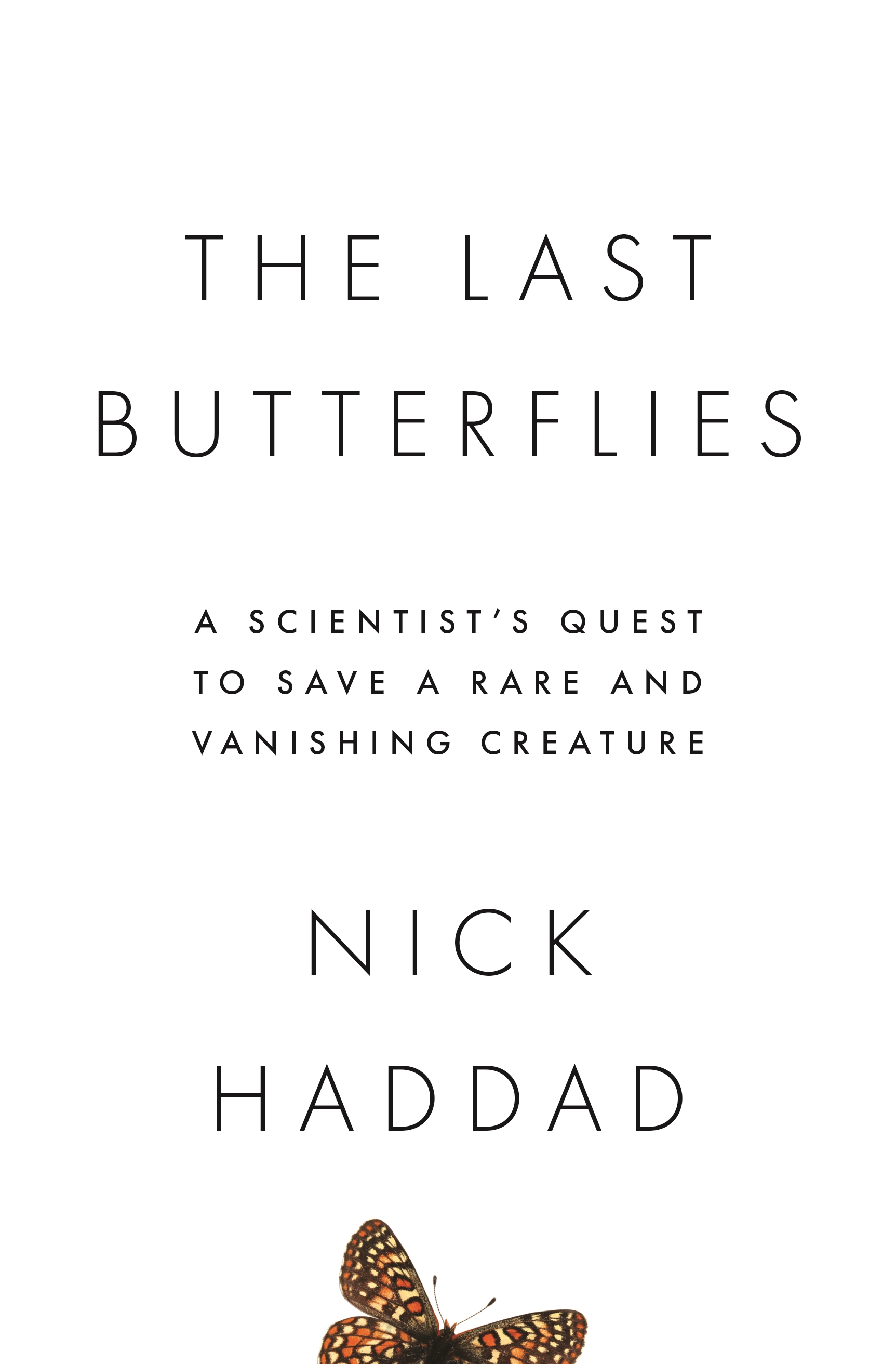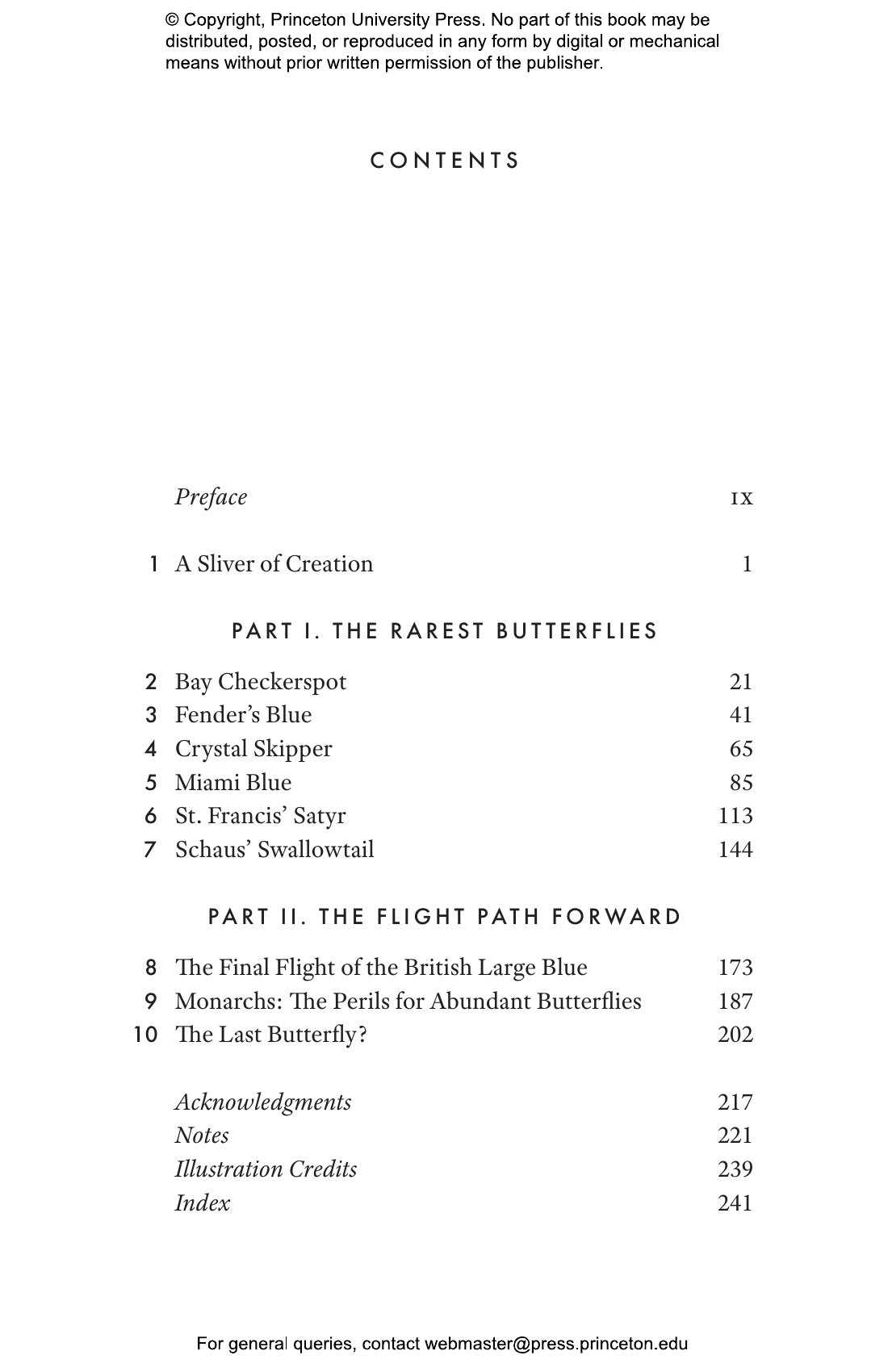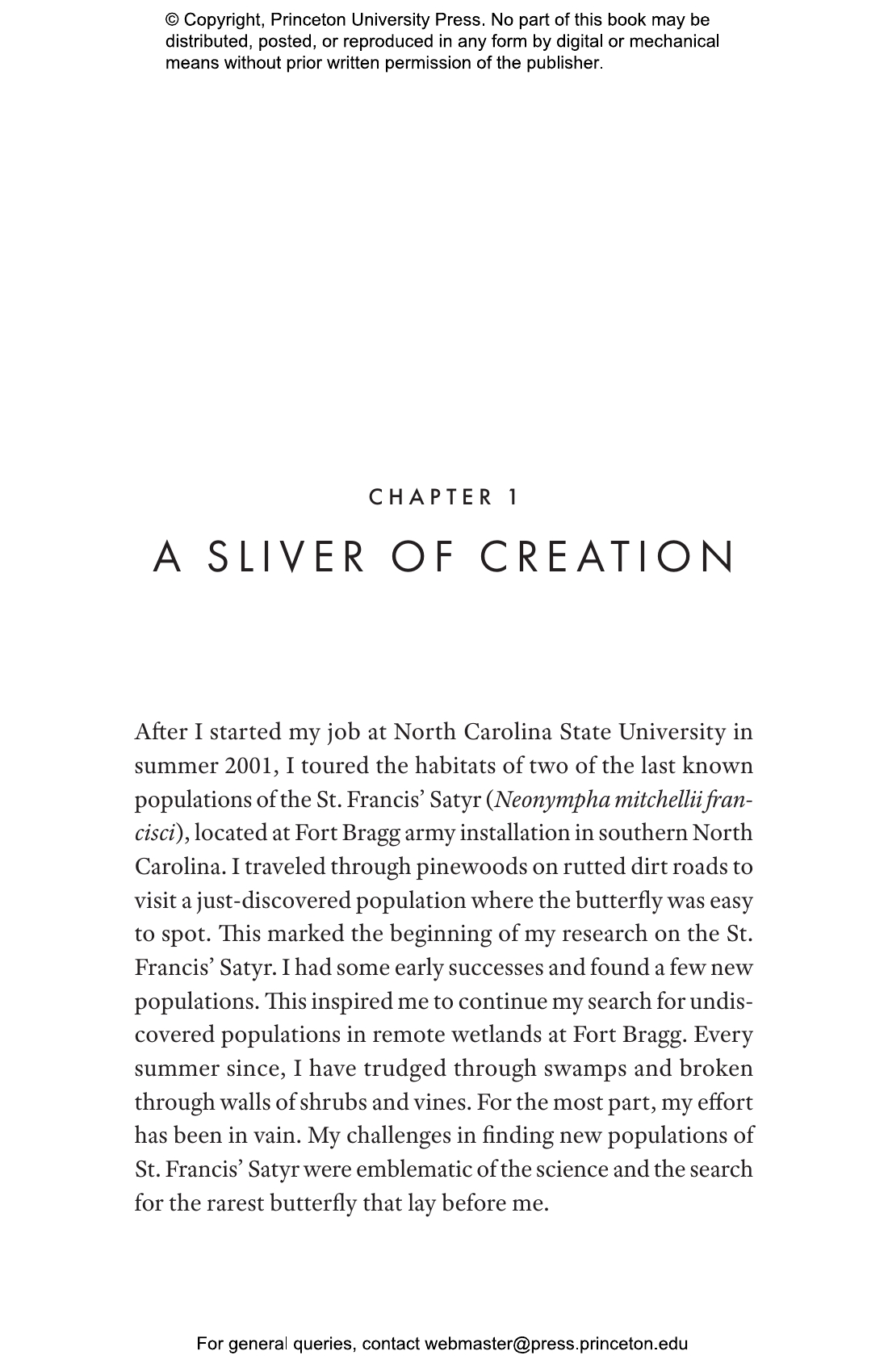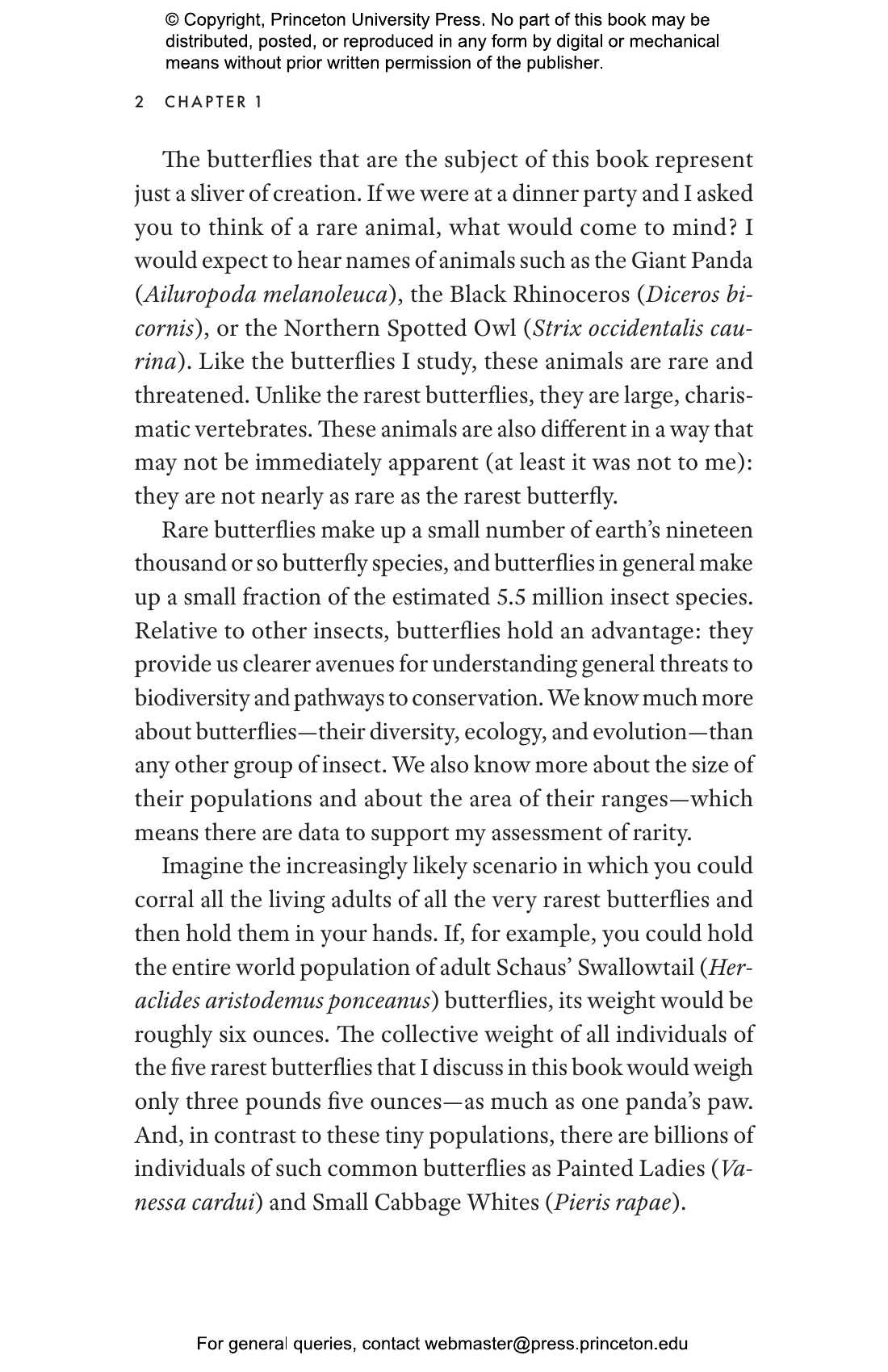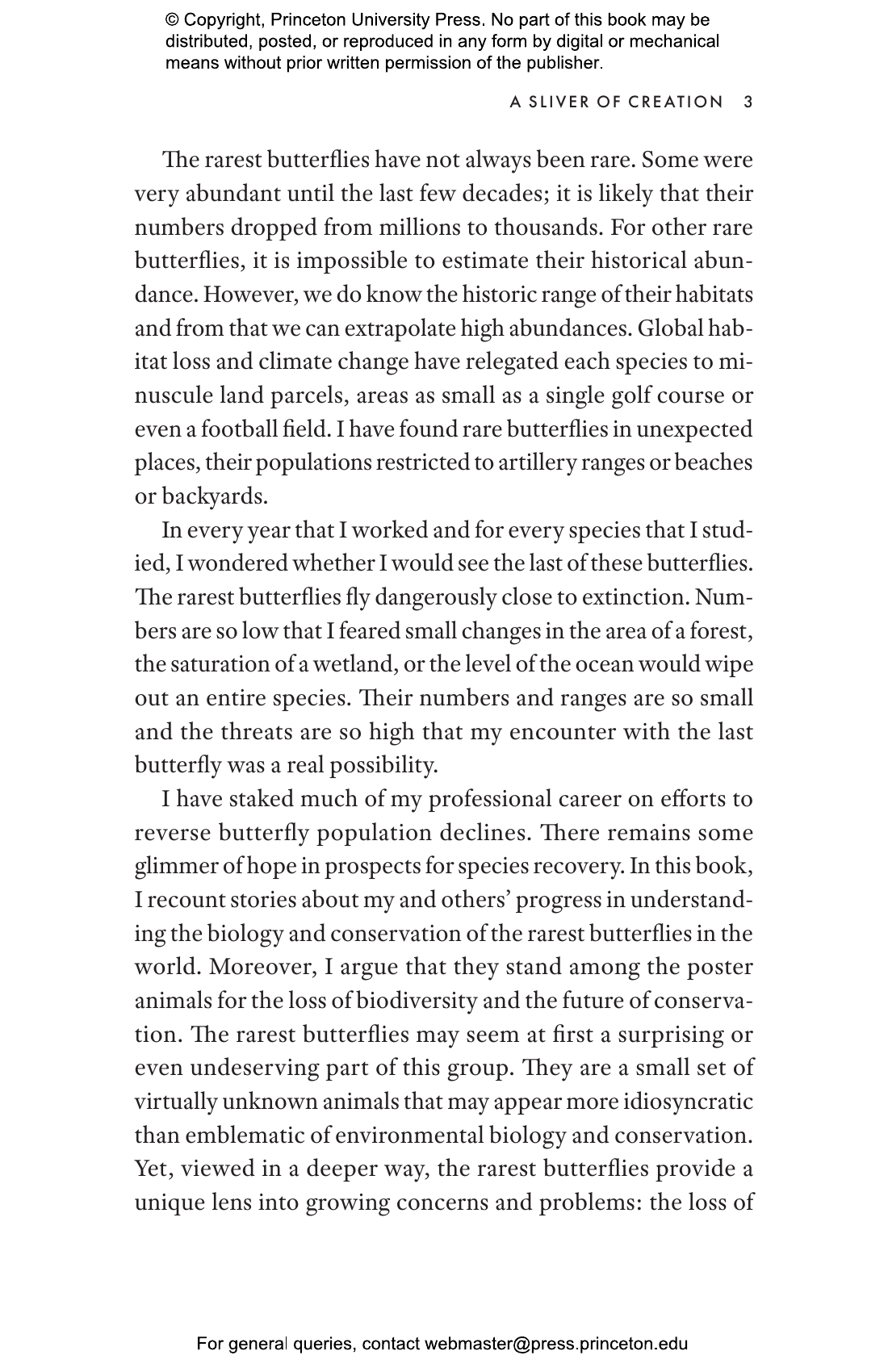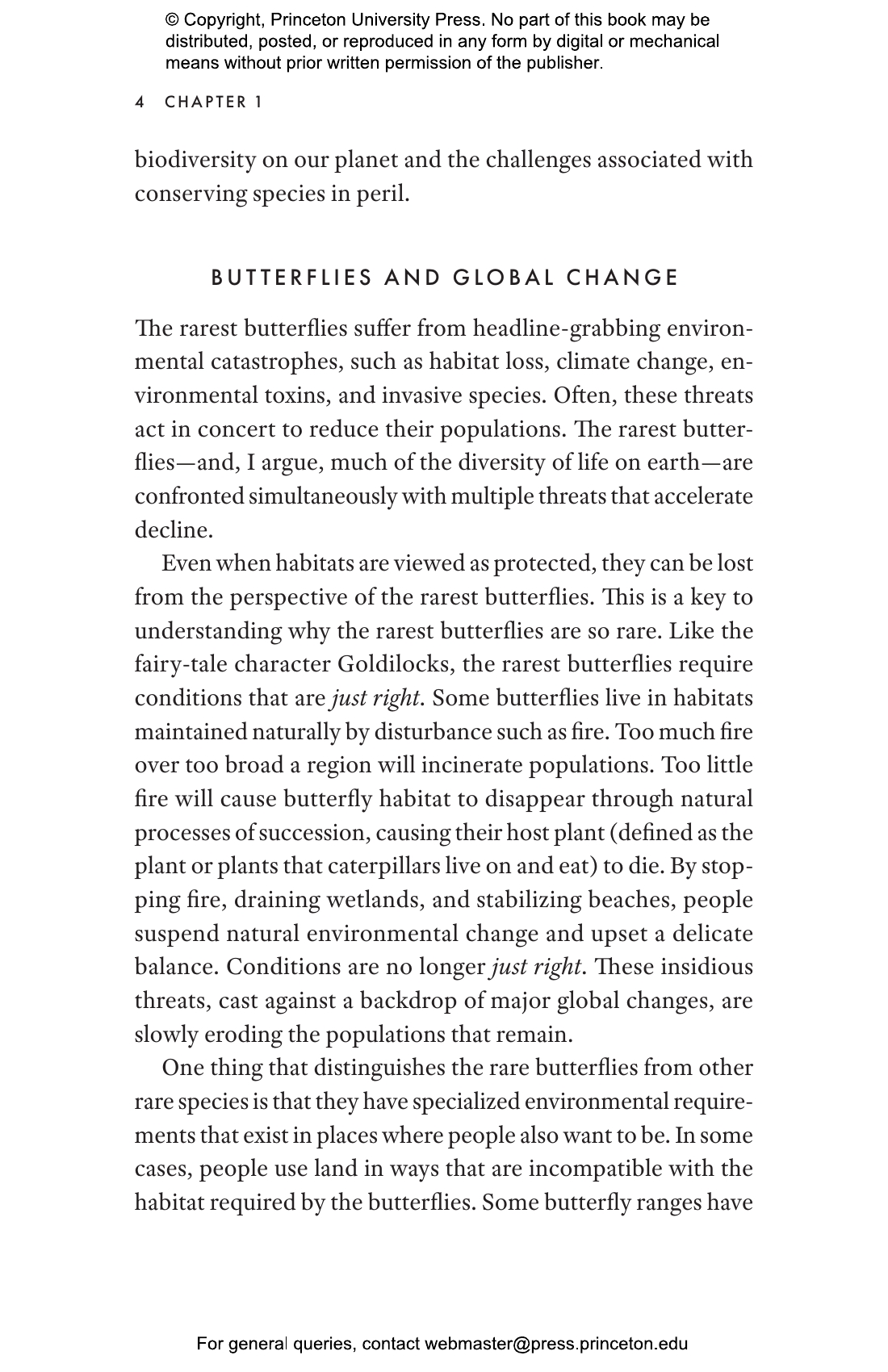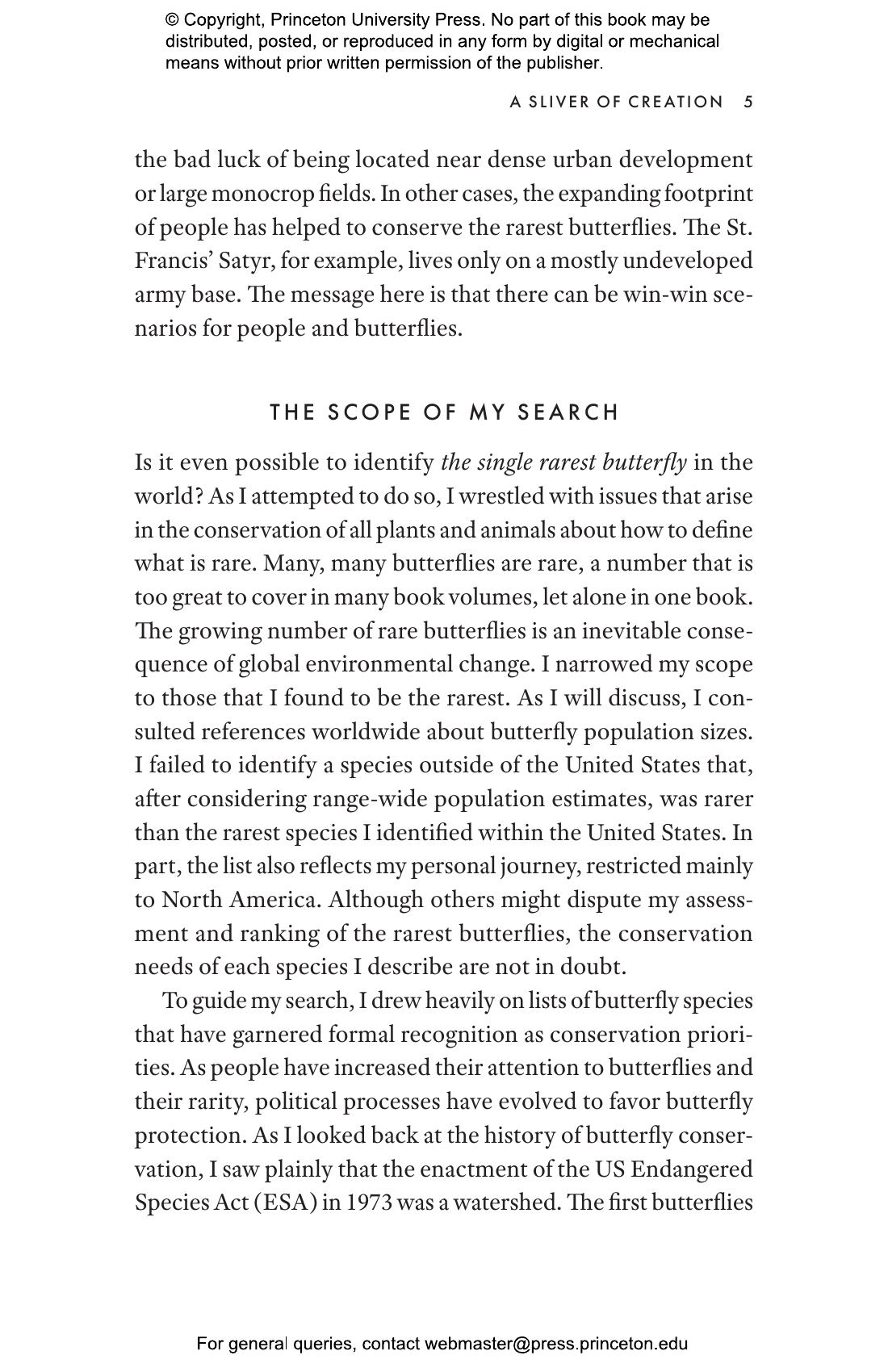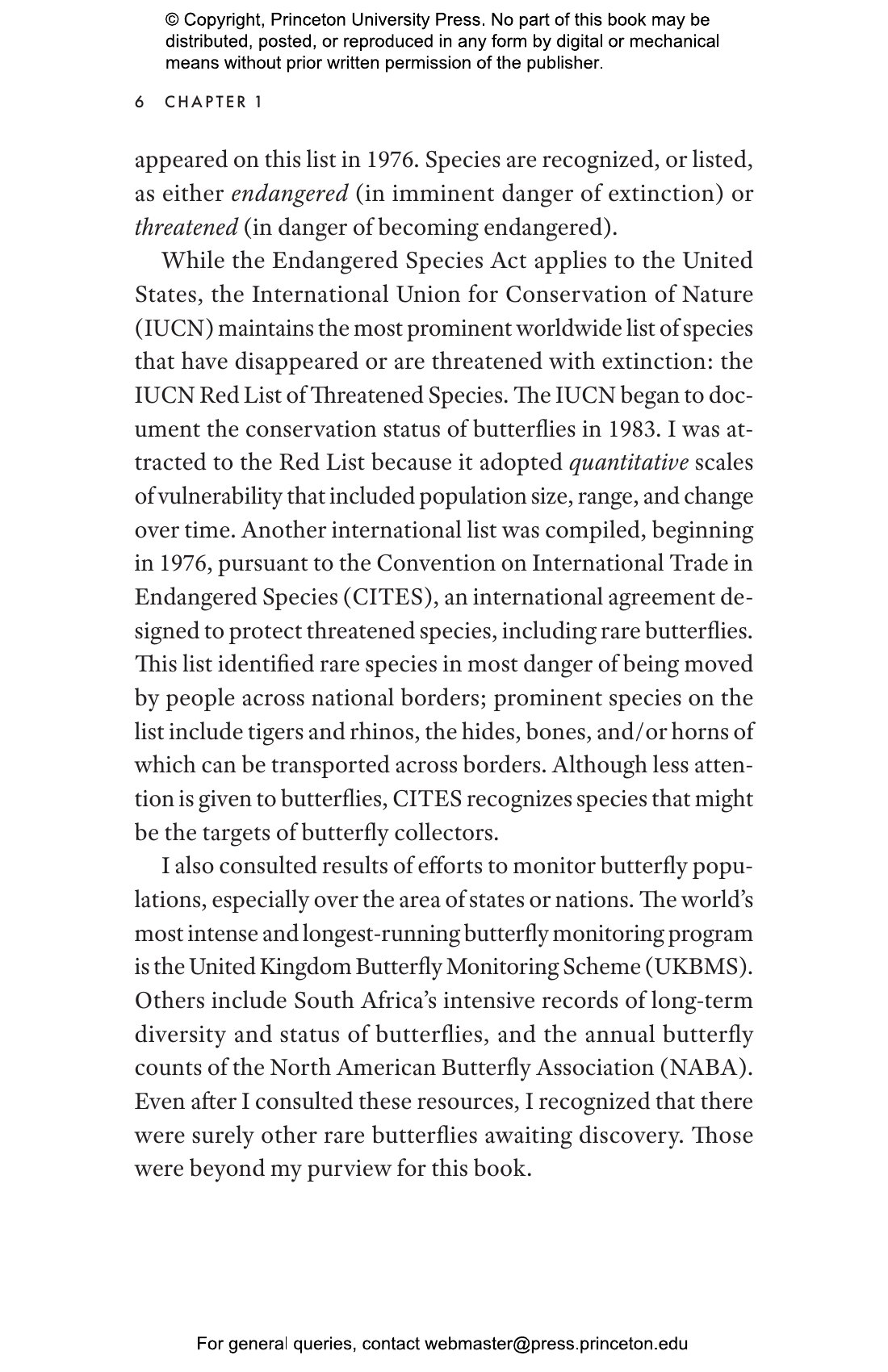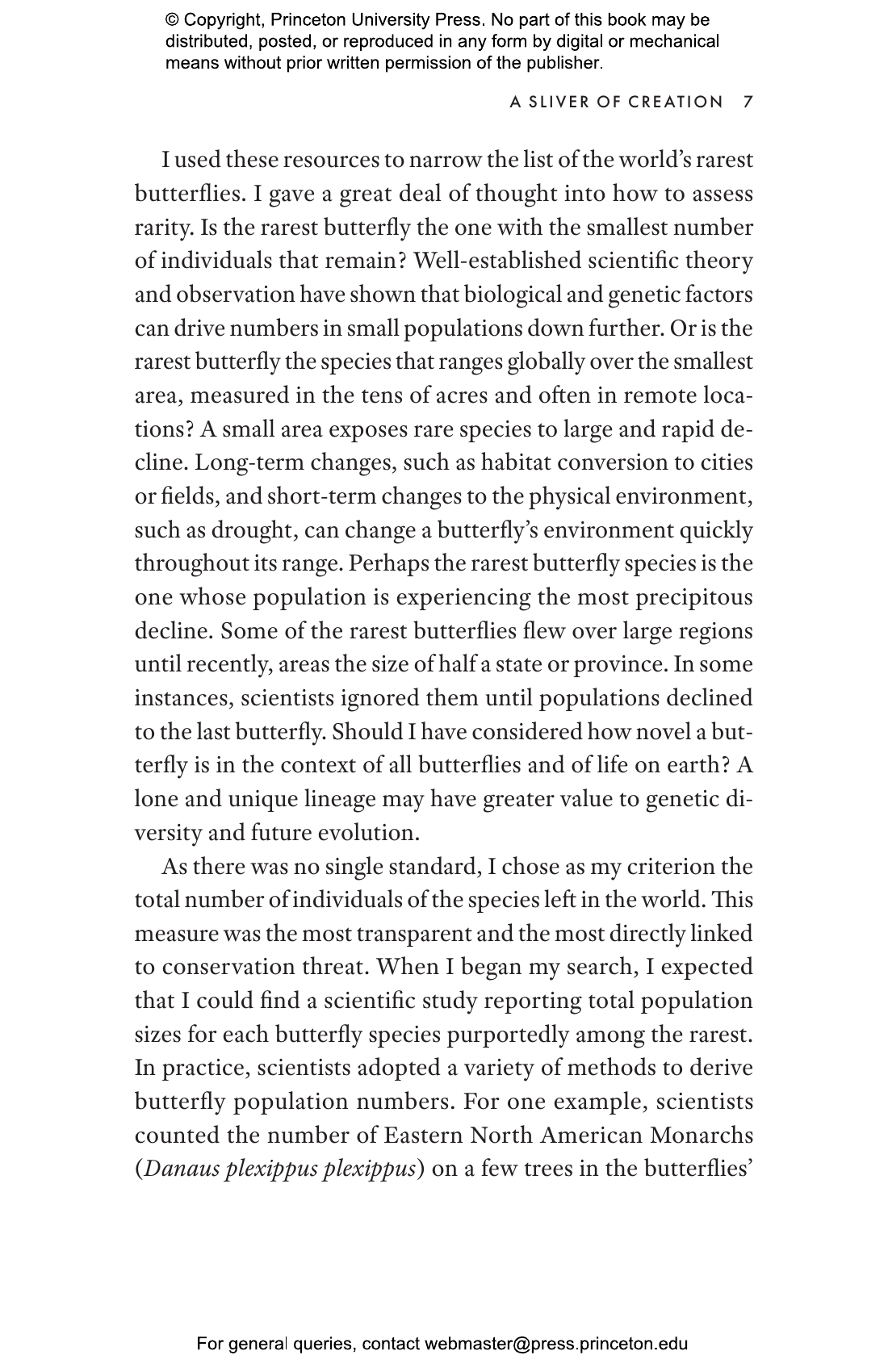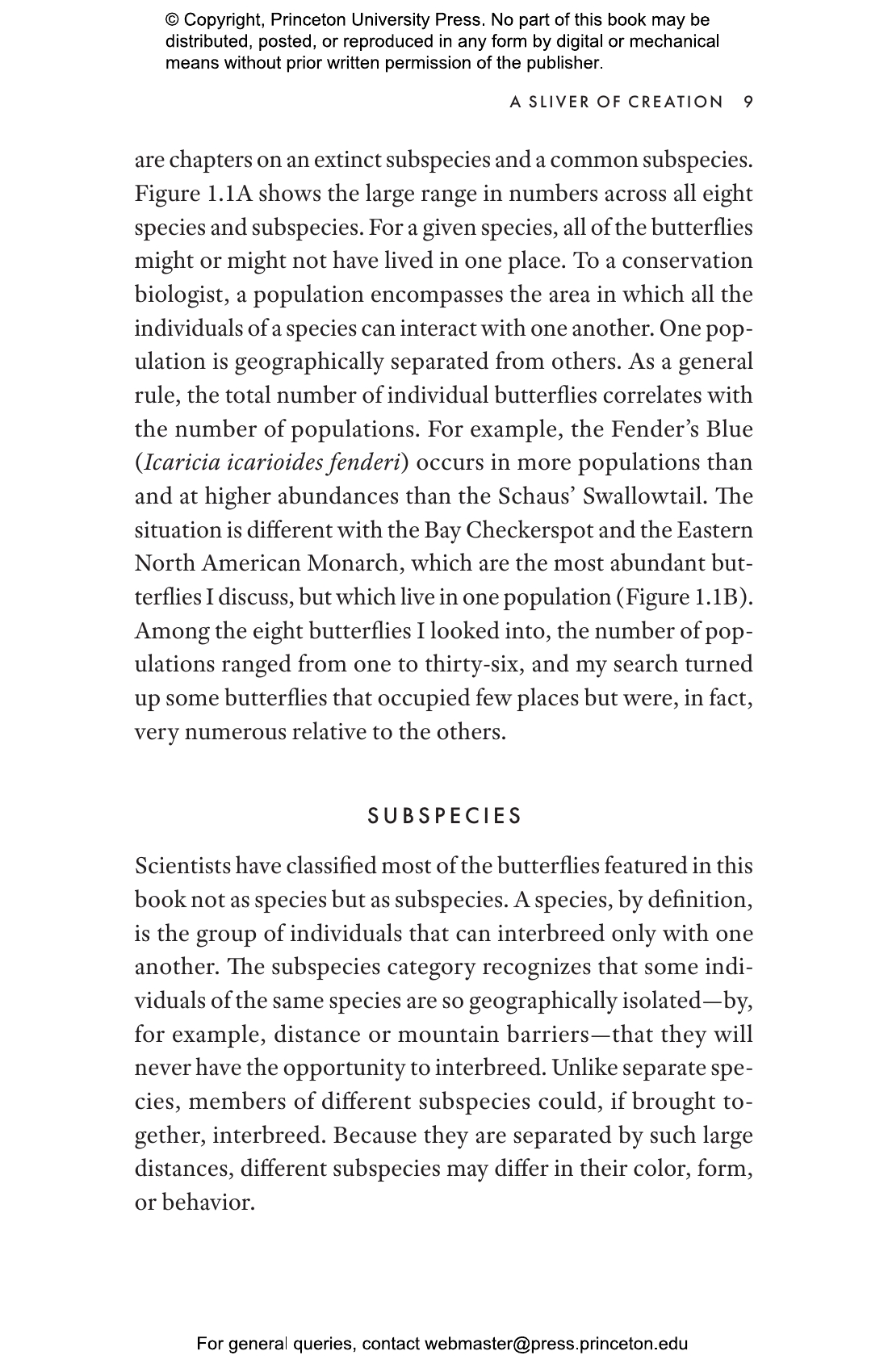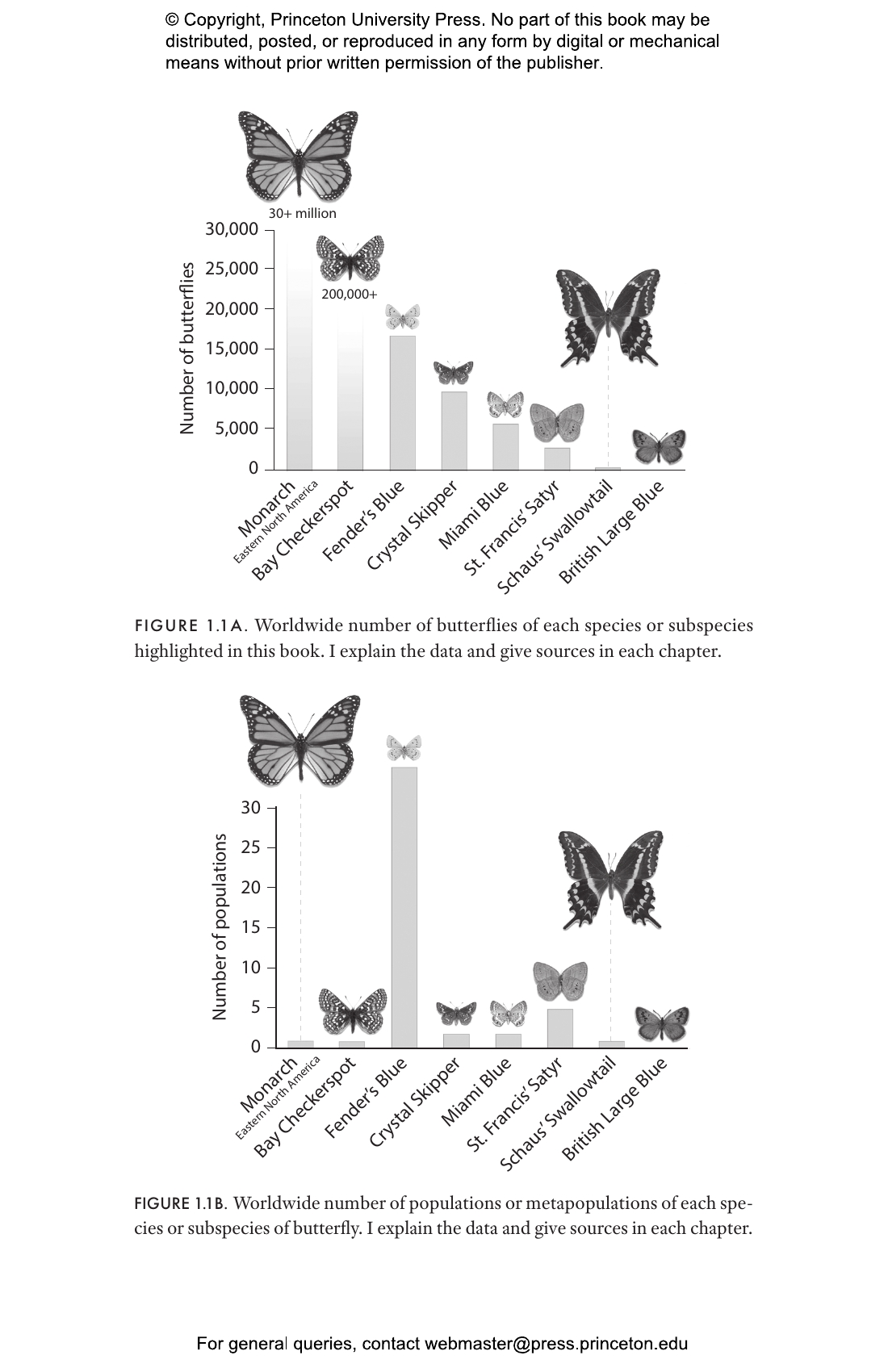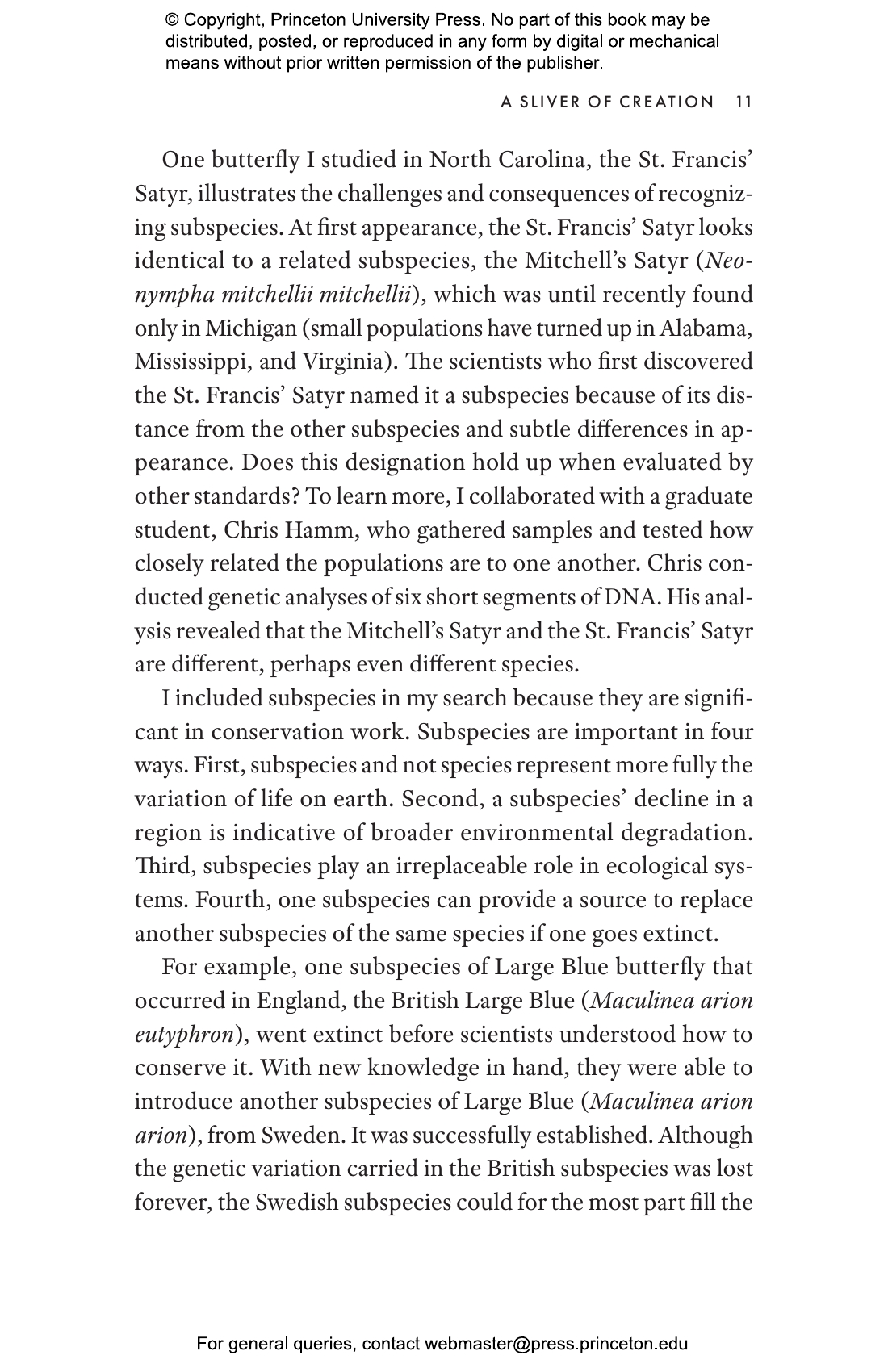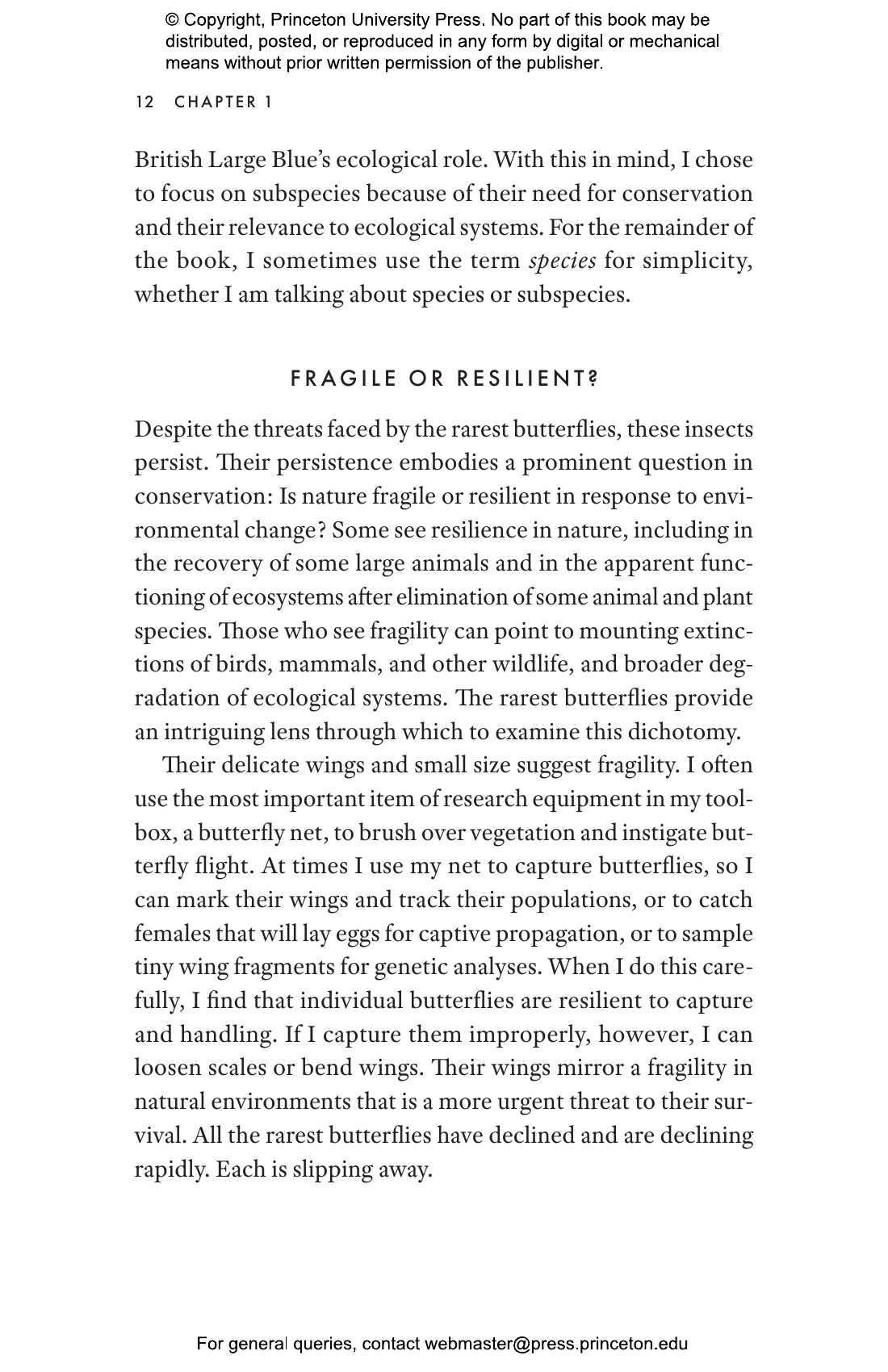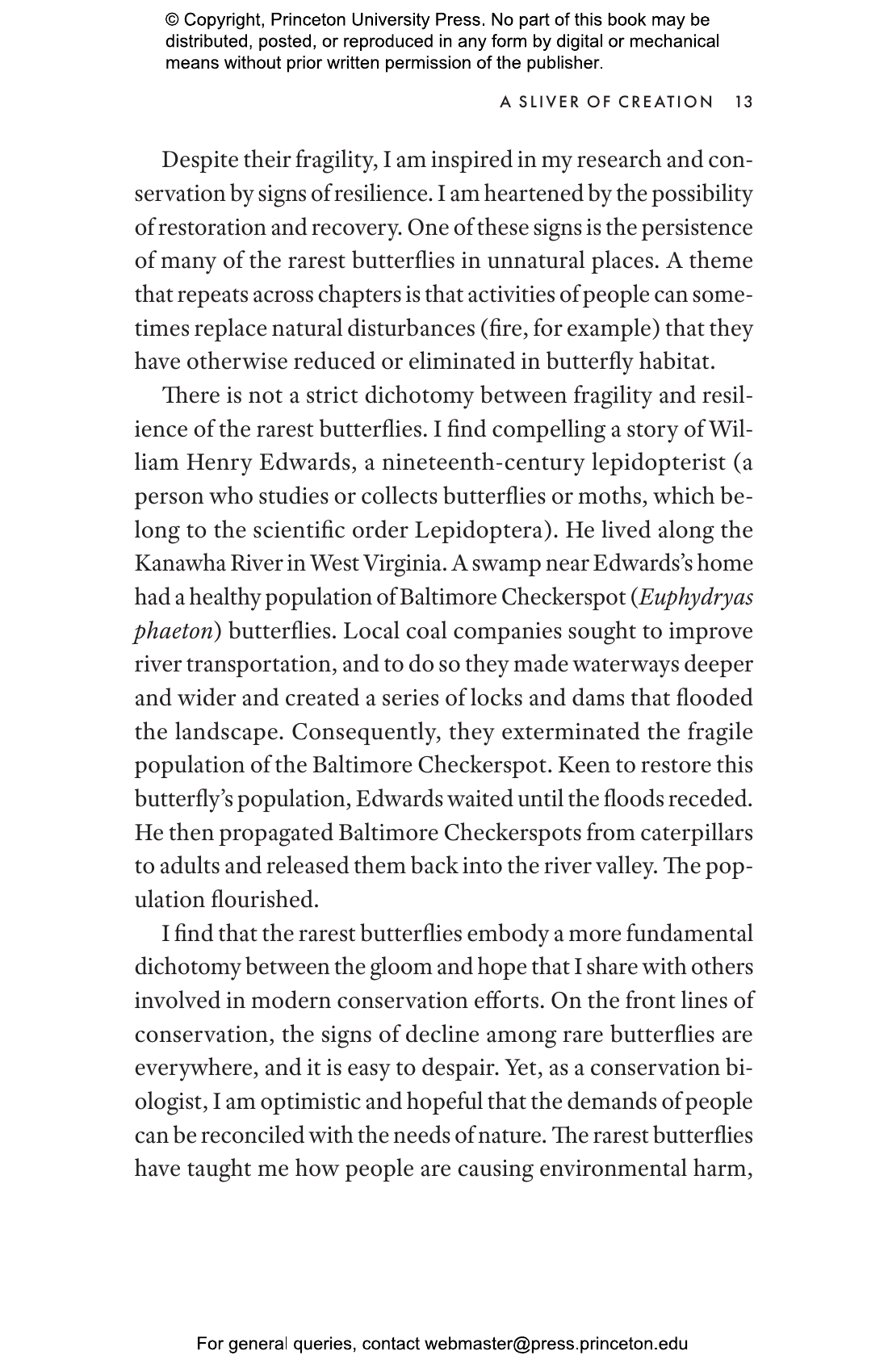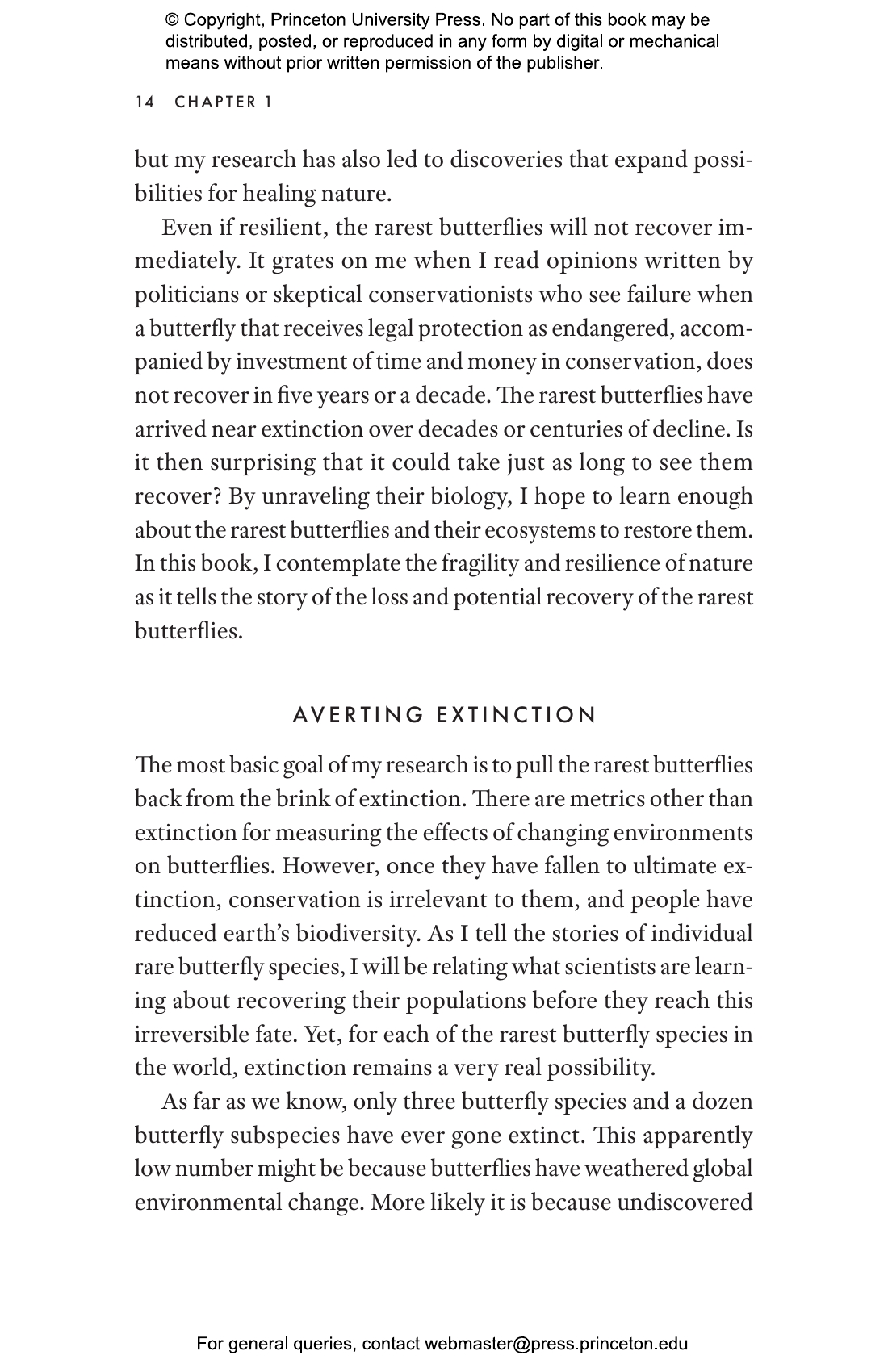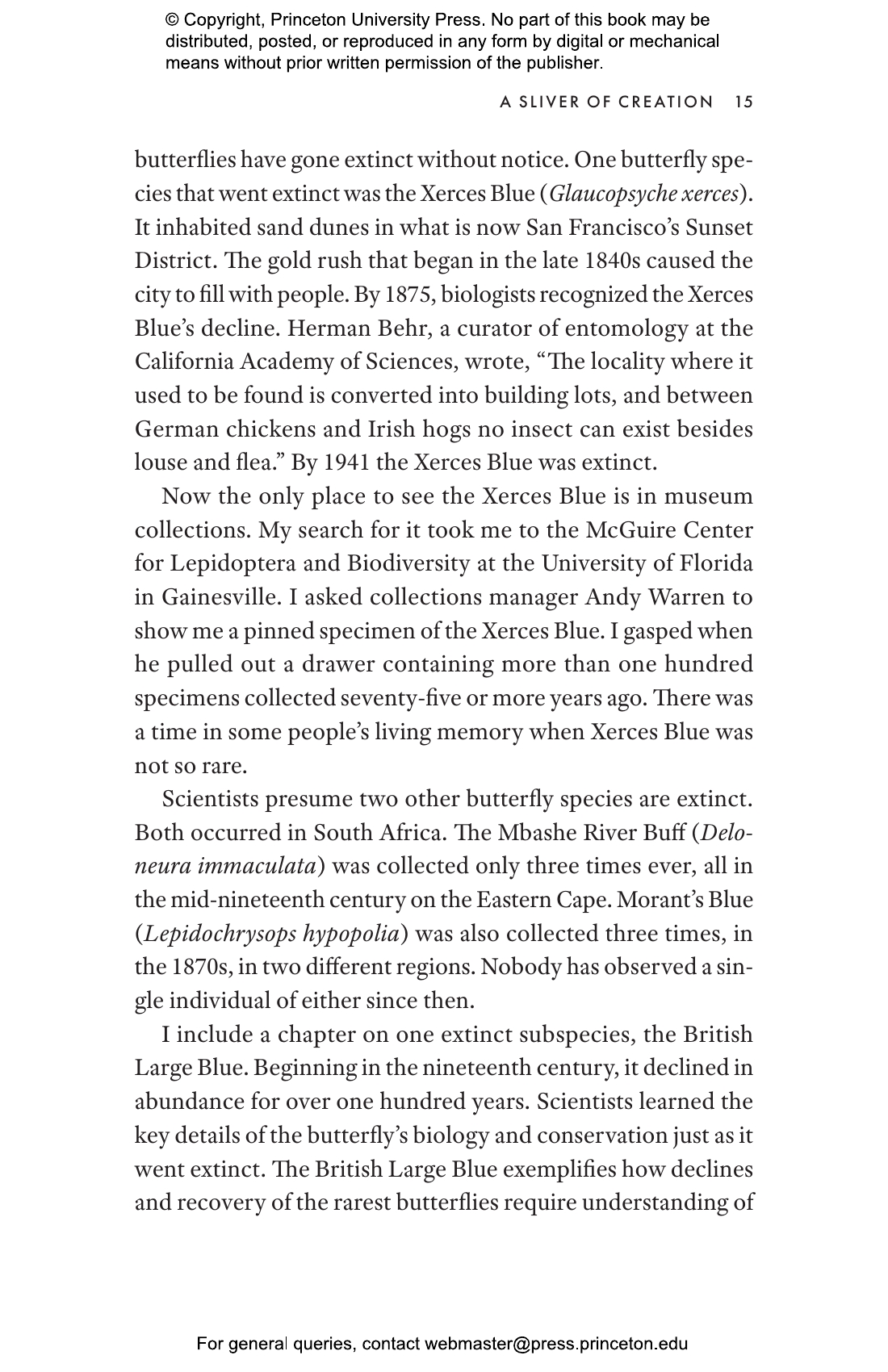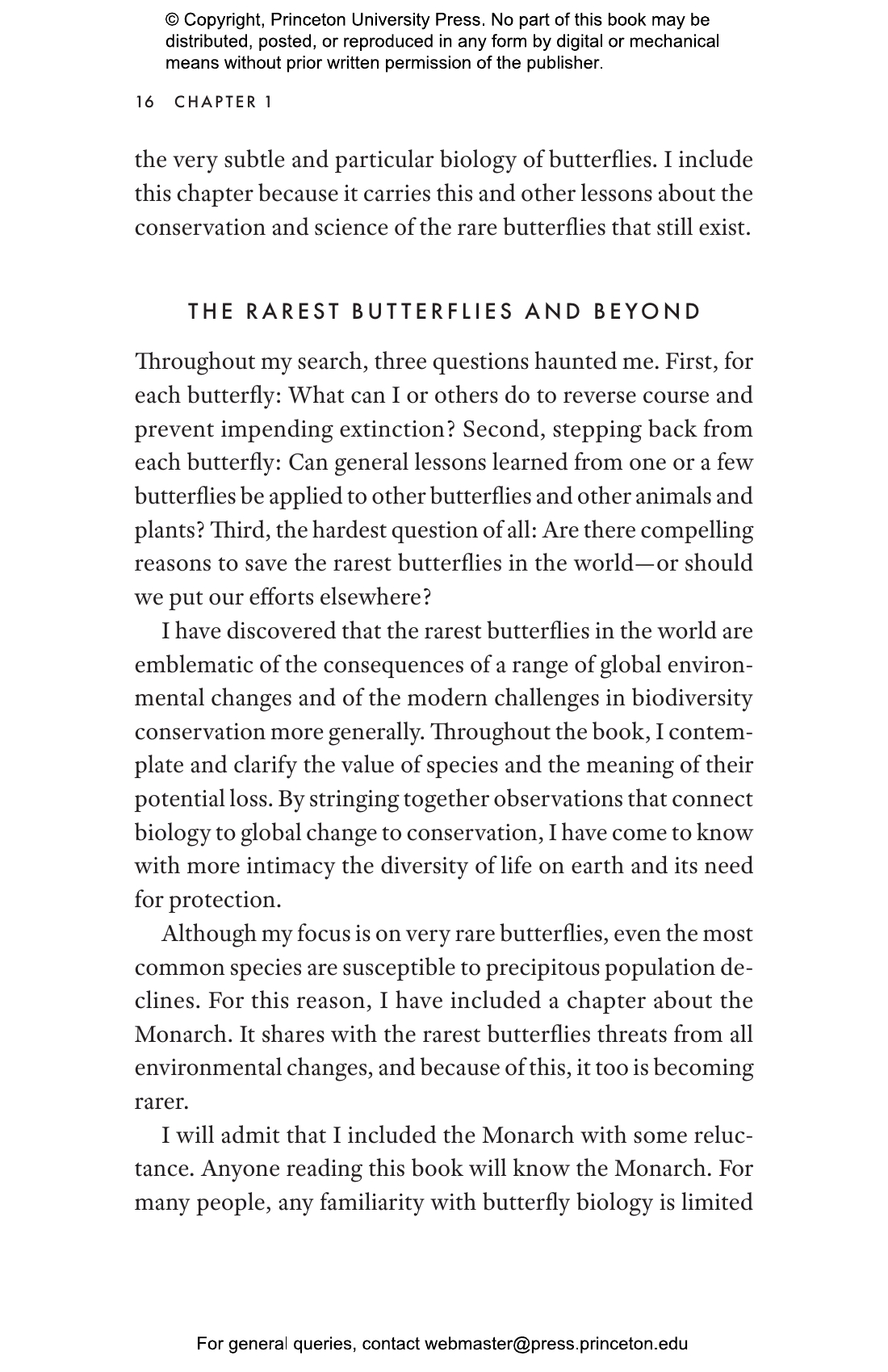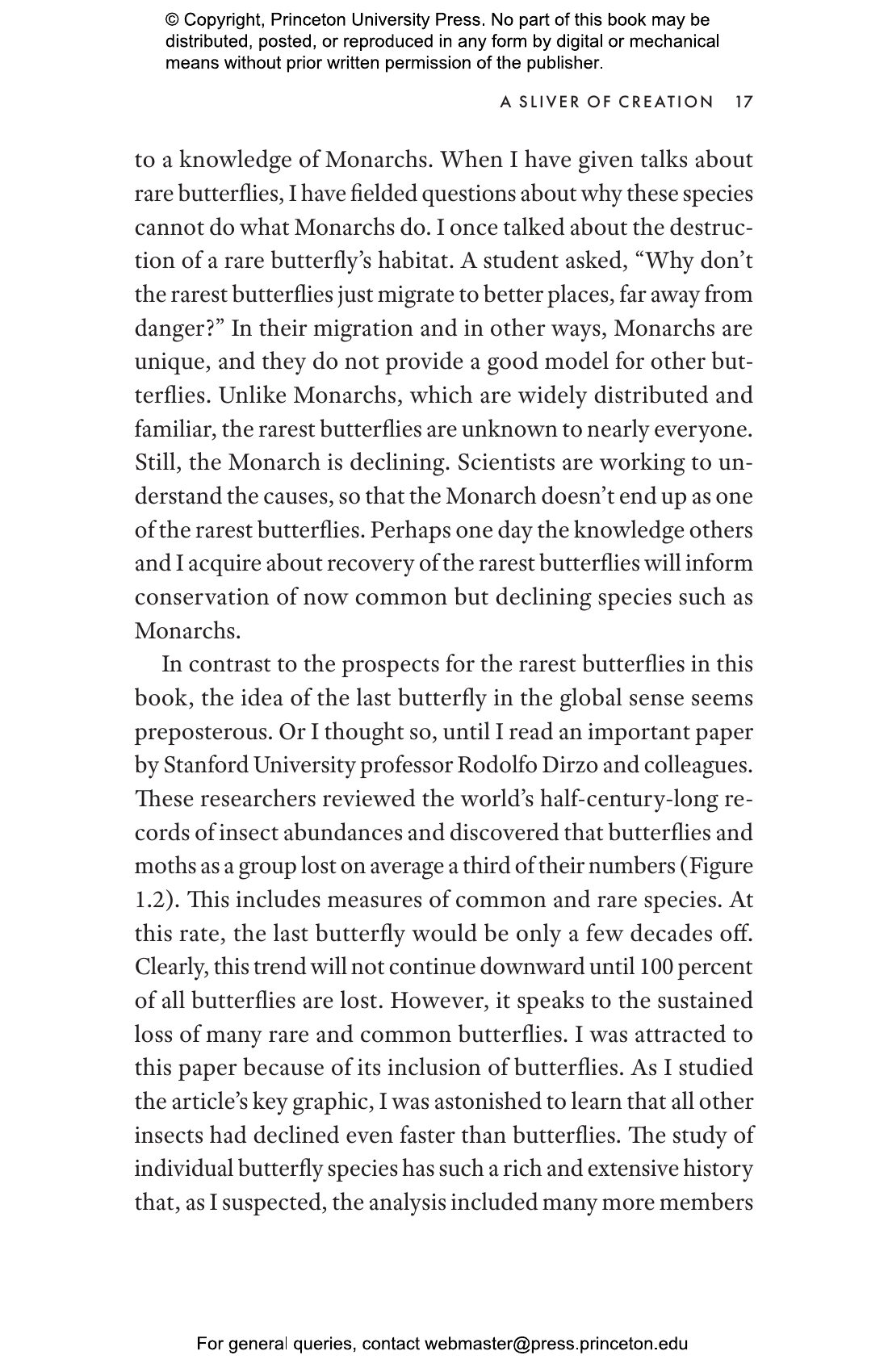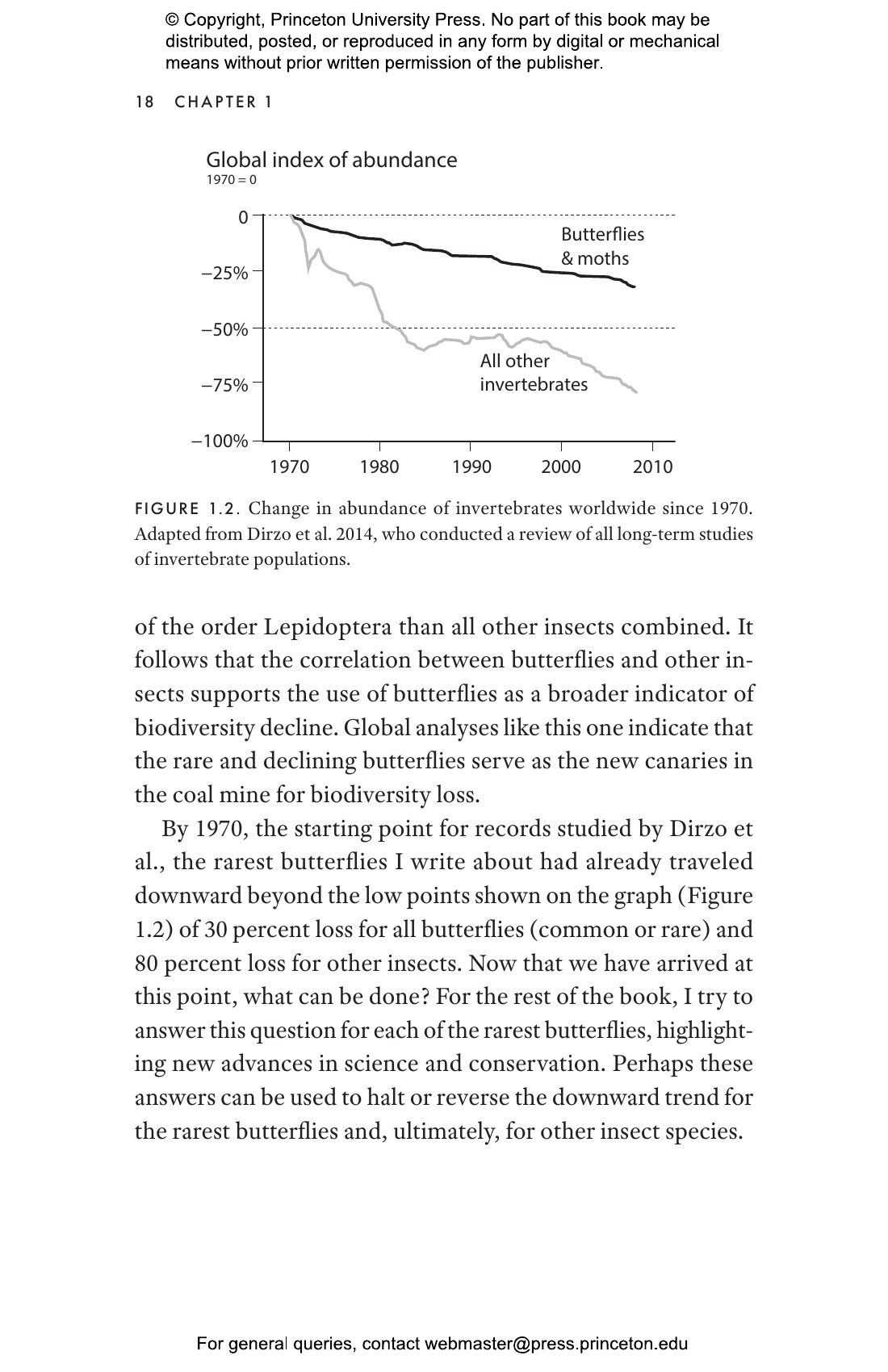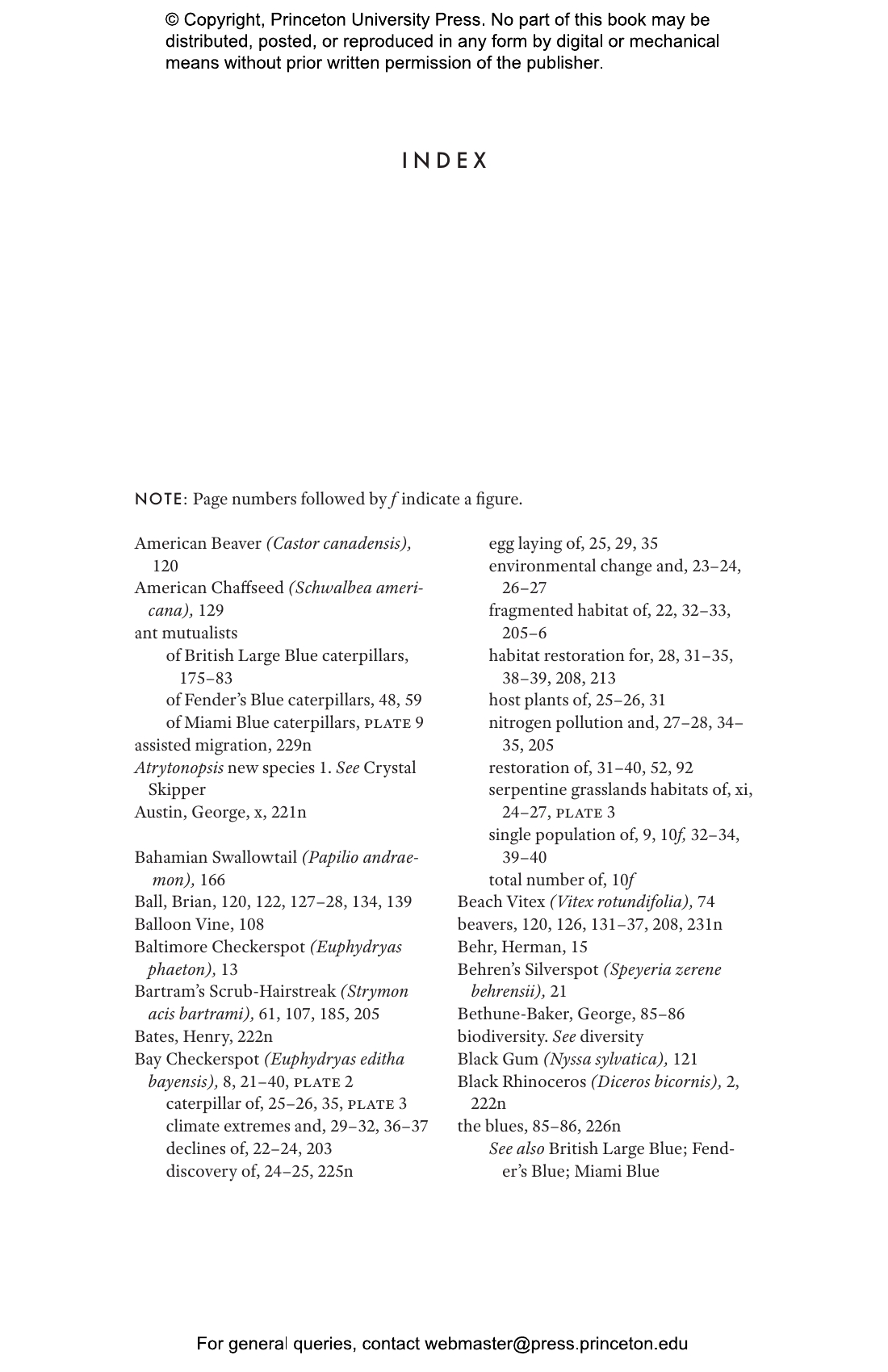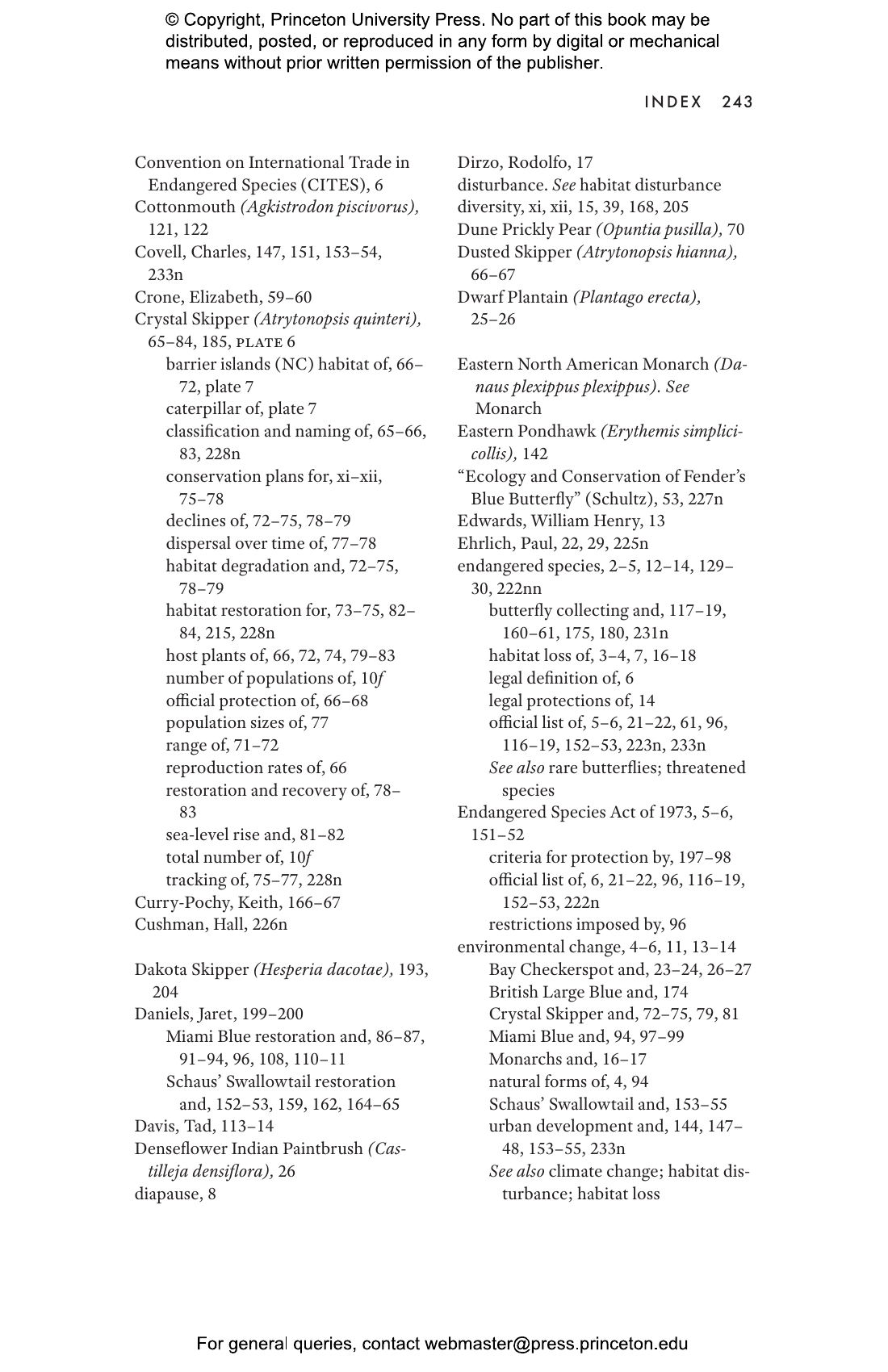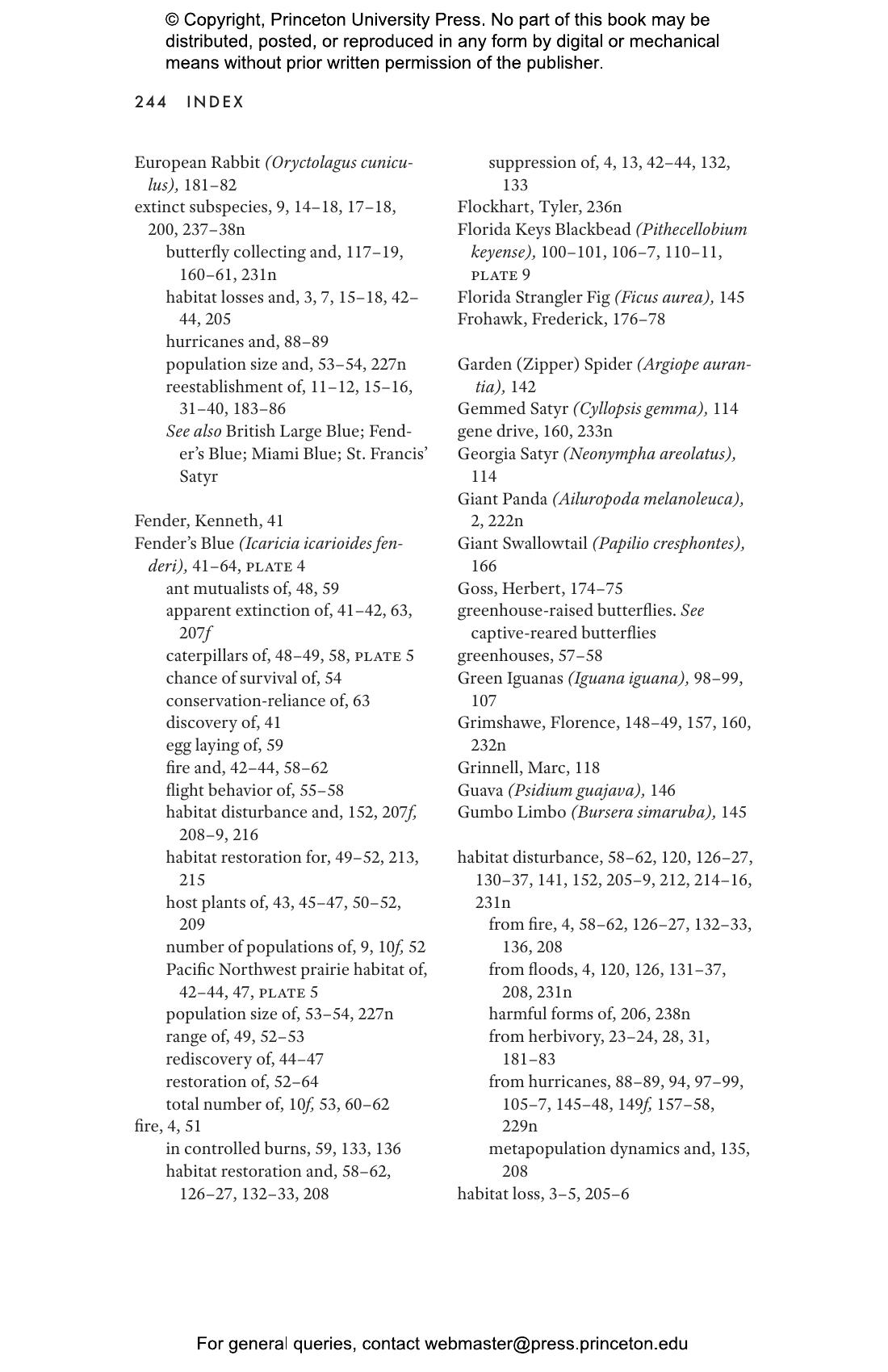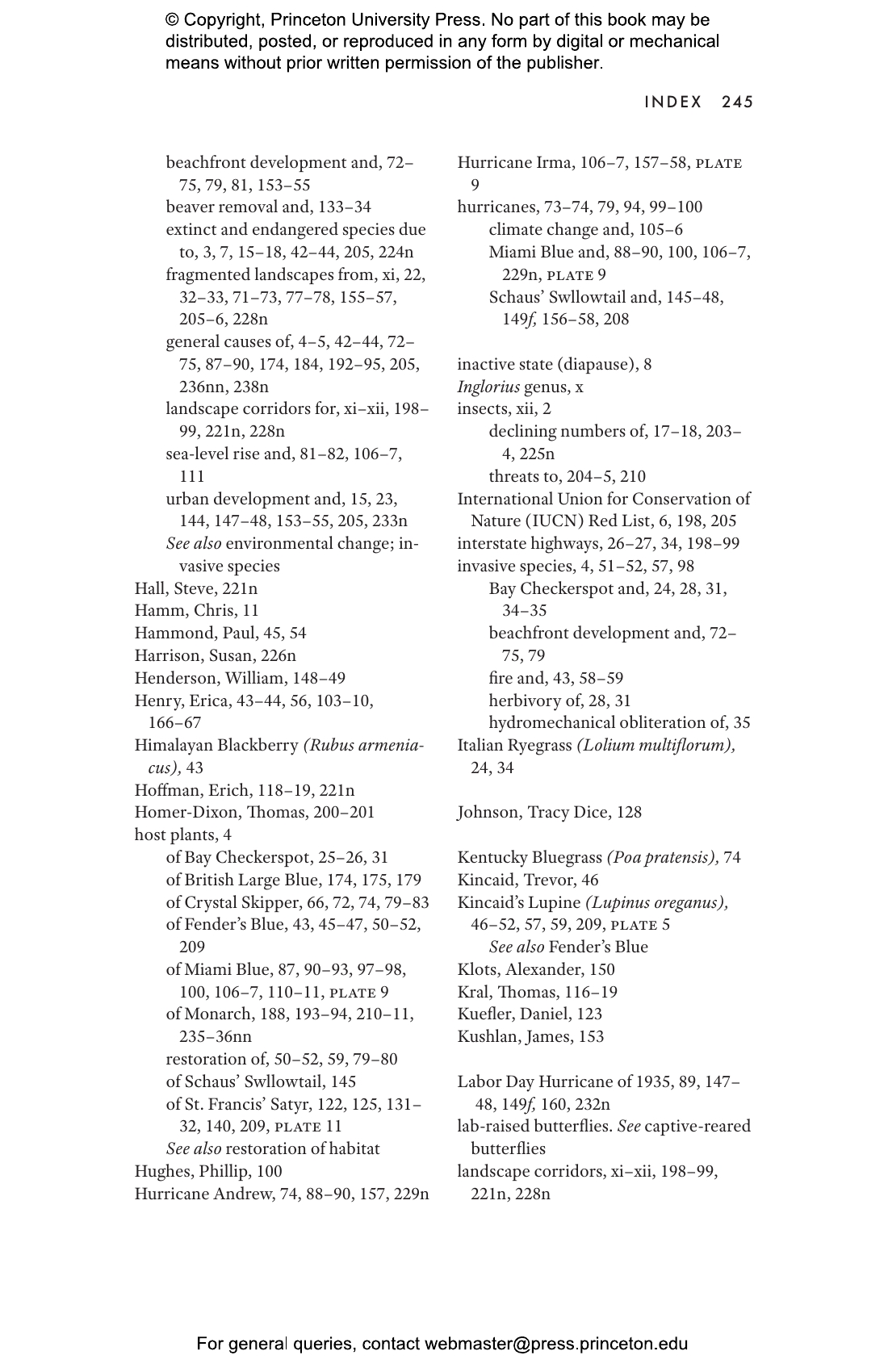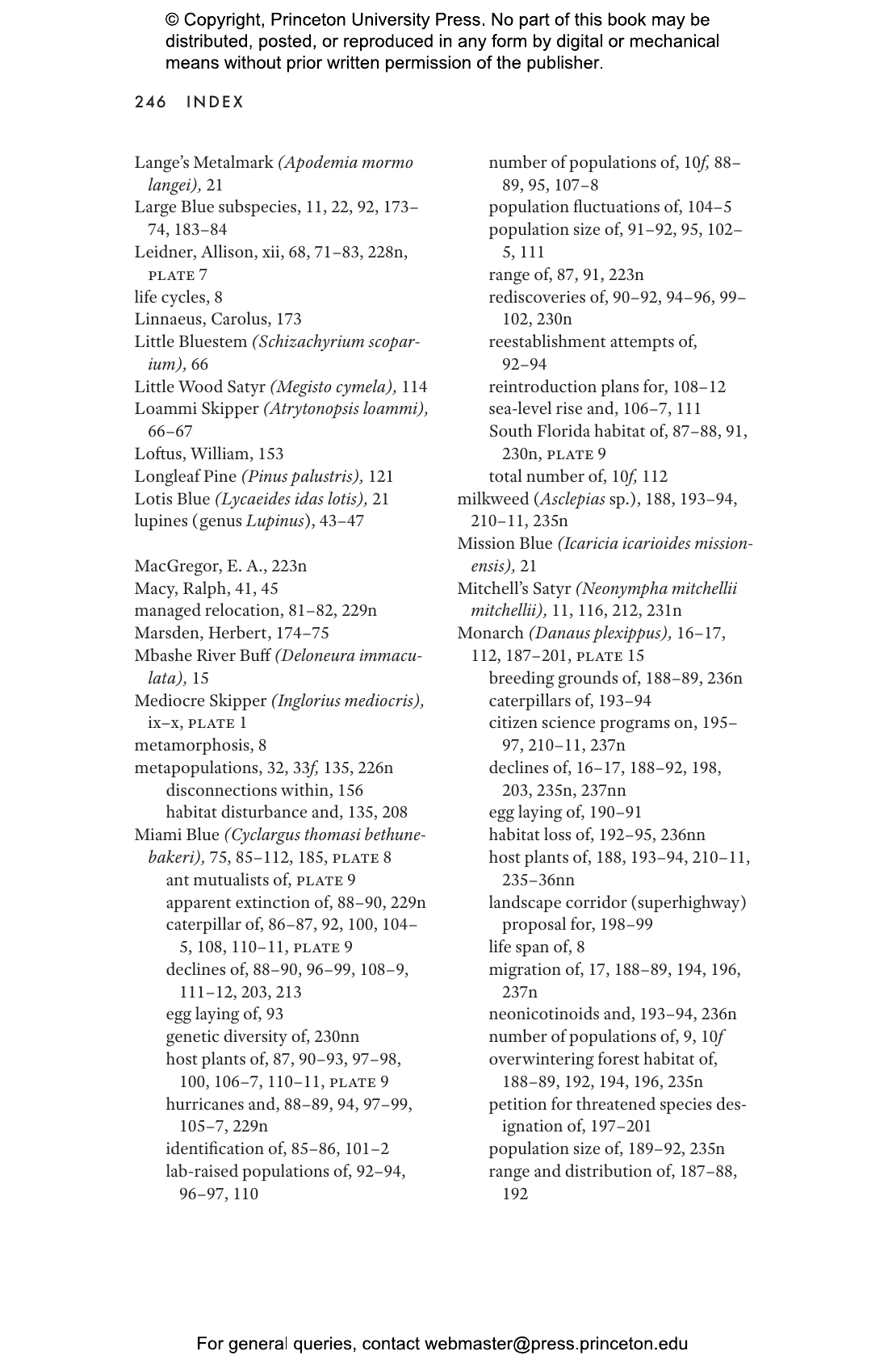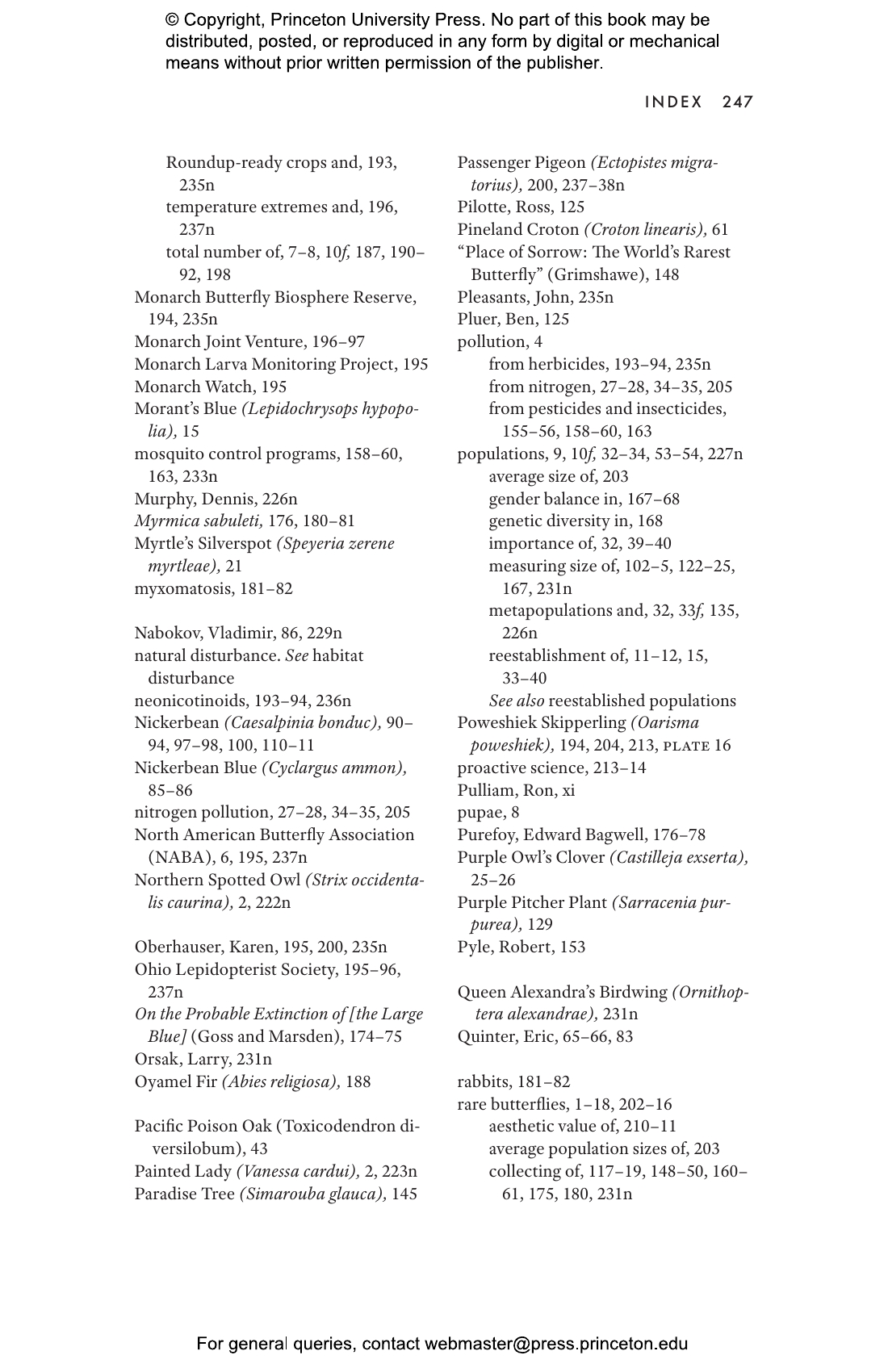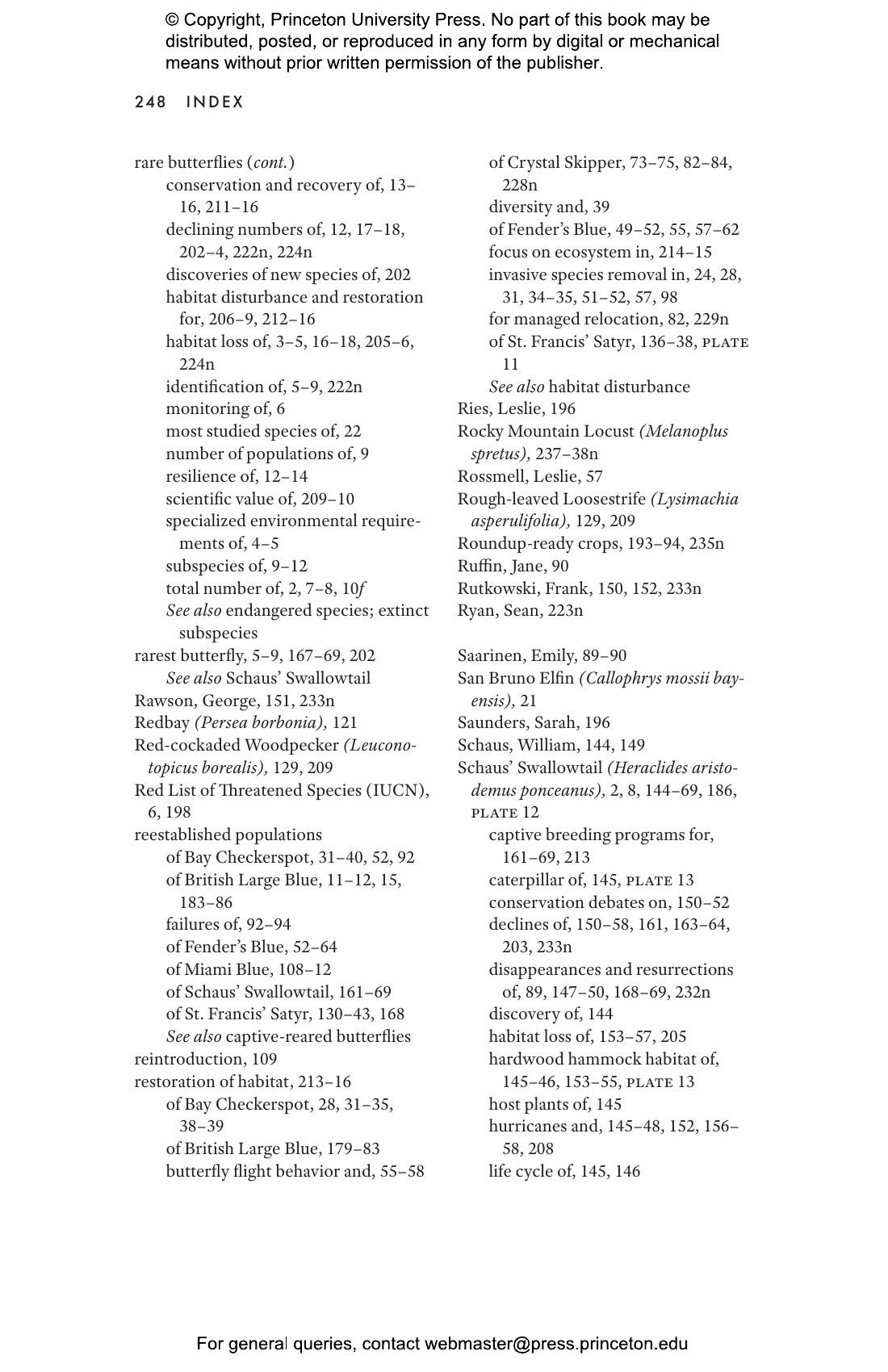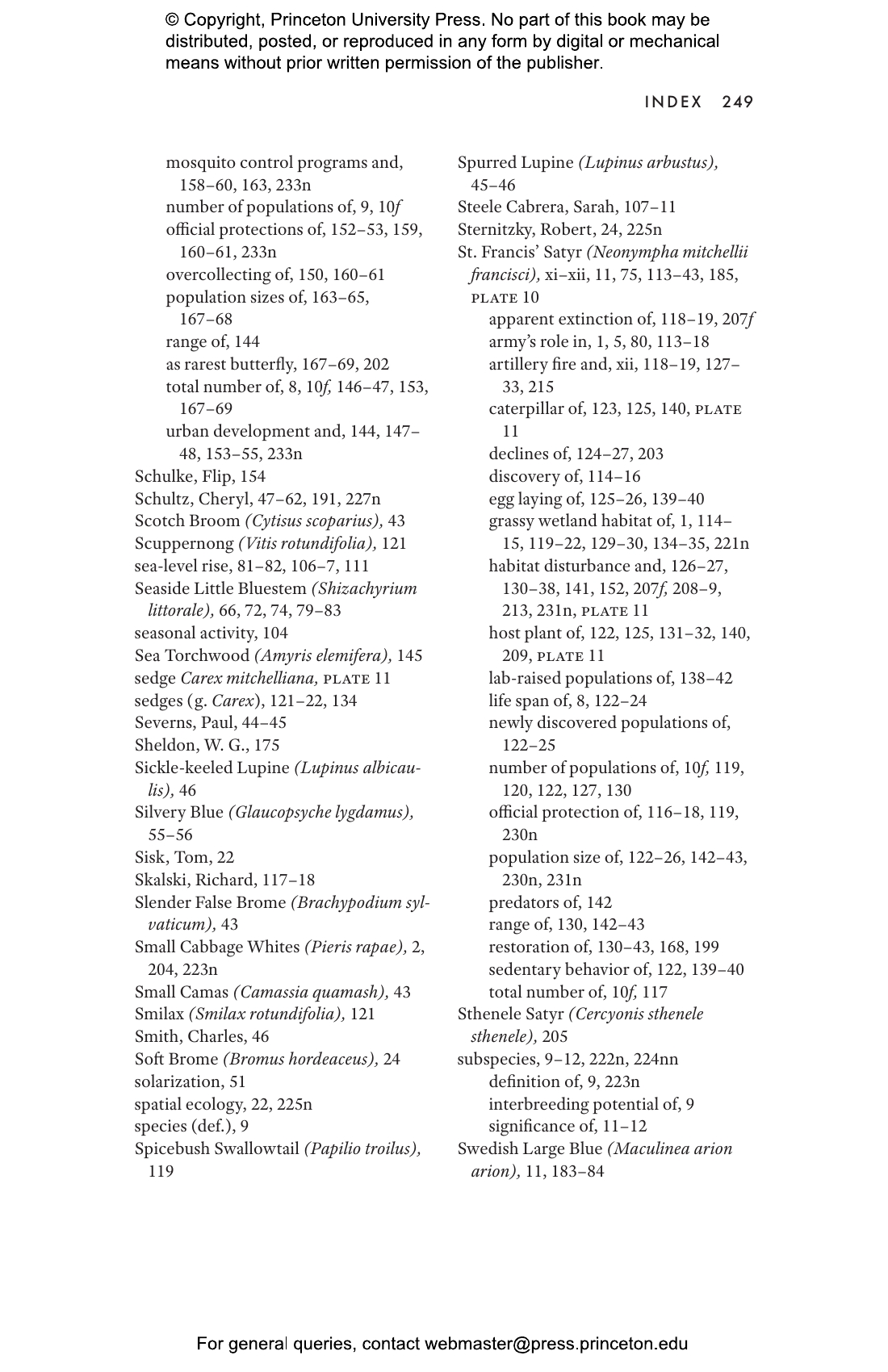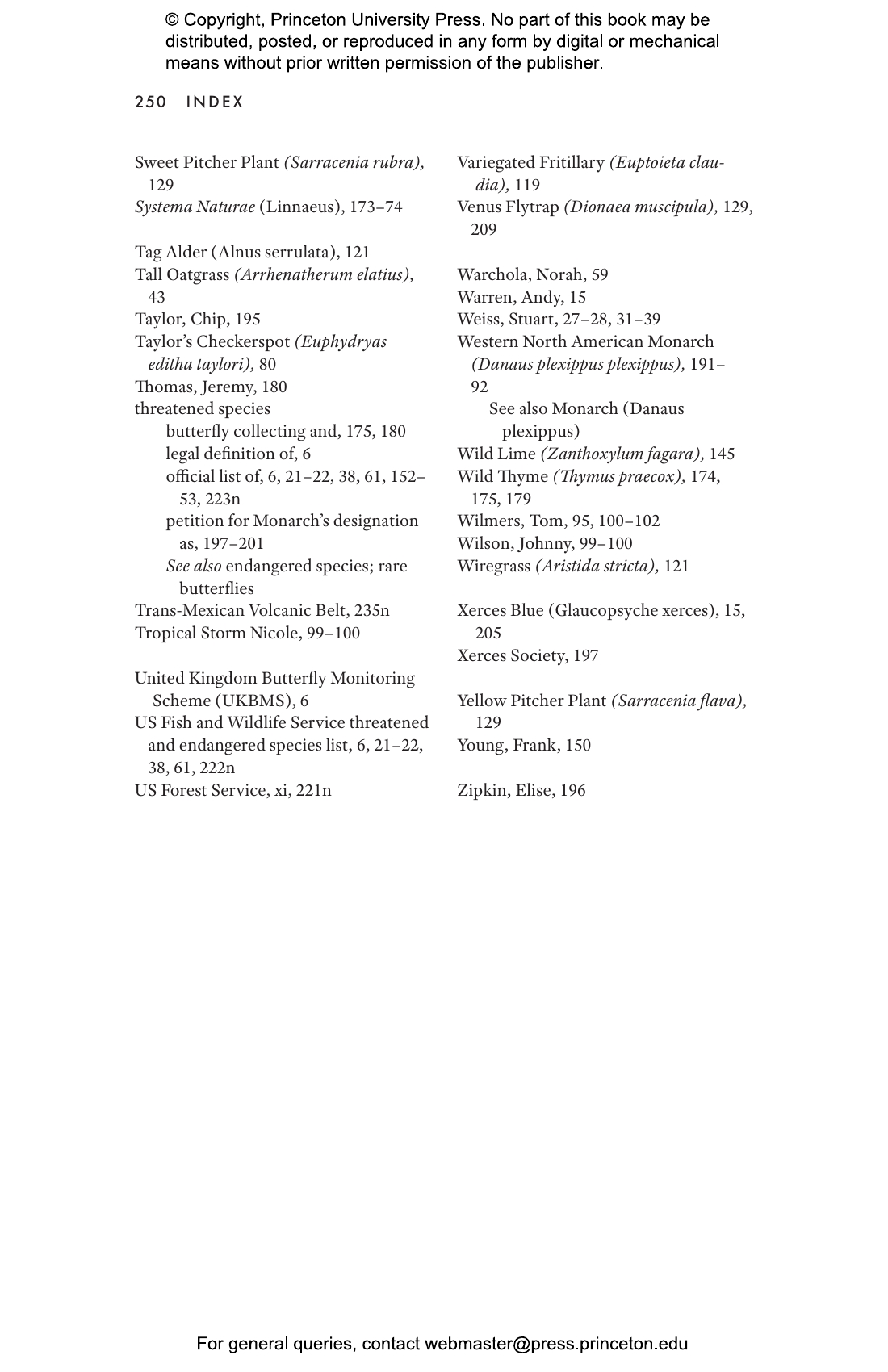Most of us have heard of such popular butterflies as the Monarch or Painted Lady. But what about the Fender’s Blue? Or the St. Francis’ Satyr? Because of their extreme rarity, these butterflies are not well-known, yet they are remarkable species with important lessons to teach us. The Last Butterflies spotlights the rarest of these creatures—some numbering no more than what can be held in one hand. Drawing from his own first-hand experiences, Nick Haddad explores the challenges of tracking these vanishing butterflies, why they are disappearing, and why they are worth saving. He also provides startling insights into the effects of human activity and environmental change on the planet’s biodiversity.
Weaving a vivid and personal narrative with ideas from ecology and conservation, Haddad illustrates the race against time to reverse the decline of six butterfly species. Many scientists mistakenly assume we fully understand butterflies’ natural histories. Yet, as with the Large Blue in England, we too often know too little and the conservation consequences are dire. Haddad argues that a hands-off approach is not effective and that in many instances, like for the Fender’s Blue and Bay Checkerspot, active and aggressive management is necessary. With deliberate conservation, rare butterflies can coexist with people, inhabit urban fringes, and, in the case of the St. Francis’ Satyr, even reside on bomb ranges and military land. Haddad shows that through the efforts to protect and restore butterflies, we might learn how to successfully confront conservation issues for all animals and plants.
A moving account of extinction, recovery, and hope, The Last Butterflies demonstrates the great value of these beautiful insects to science, conservation, and people.
Awards and Recognition
- Longlisted for the Young Adult Science Book Award, AAAS/Subaru SB&F Prize for Excellence in Science Books
"There are heroes in this story, and Haddad does a wonderful job of celebrating them."—Jonathan Hahn, Sierra
"A valuable lens on the biodiversity crisis. Yet Haddad does not just gather data on habitat loss and other drivers of decline—although he does that with crystalline acuity. He emphasizes that measures such as restoring ecological systems can protect populations of these fragile 'ambassadors of nature', against the odds."—Barbara Kiser, Nature
"Haddad eloquently argues that conserving butterflies is not about preserving an organism or habitat in aspic—that way lies stagnation and decline—it’s about enabling a dynamic and resilient environment."—Richard Jones, BBC Wildlife Magazine
"Wonderfully informative . . . Haddad has that rare ability to make difficult science accessible to those of us who are not trained in the nuances of ecological quantification and he does so without talking down to us."—Keith Taylor, WUOM’s Stateside
"A powerful study of what a declining insect population reveals about how we are treating the planet . . . . fine and compelling book."—Jules Pretty, Times Higher Education
"We need to do better at embedding nature conservation, knowledge generation, and long-term monitoring as core goals in land management initiatives. The Last Butterflies shares some inspiring examples of how to achieve this."—Manu. E. Saunders, Trends in Ecology & Evolution
"Haddad is extremely knowledgable about this subject, and is also able to successfully communicate that knowledge to a wider audience"—Harry Siviter, The Biologist
"The Last Butterflies does a remarkable job weaving together the stories of the rarest of butterflies, changing landscapes, and the day-to-day work of the scientists who study them."—Gretchen LeBuhn, American Entomologist
"The author has devoted his life to butterflies . . . His guiding principle is that humans should not be the cause of the extinction of these extremely rare species by promoting rather than destroying biodiversity - it is a moving personal ecological odyssey."—Paradigm Explorer
"[The Last Butterflies] is infused with enthusiasm for conservation efforts, both now and in the future, and with an admiration for the beauty, fragility, and resilience of butterflies. It is an important book for anyone concerned with biodiversity and conservation issues. It’s also an eye-opening and engaging read for anyone with an interest in butterflies."—Rachel Pagones, New Books in Environmental Studies
"This is an unusual, honest and informative book. . . . clearly written and attractively presented."—John Tennent, Atropos Magazine
"A nice read that those interested in conservation will enjoy. . . . the author argues that even if rare butterflies may make a negligible contribution to ecological services, there are still compelling reasons to protect them."—Conservation Biology
"One of the best books about conservation biology that I’ve read in a long time. The Last Butterflies reads with the ease of a novel. Part adventure tale and part detective story, it leads you in search of the world’s rarest butterflies and the ways we might save them."—Matthew Shepherd, Wings
"If you are interested in conservation, butterflies, insects, or any combination of the three, I would recommend picking up this volume."—Cas Carroll, The Quarterly Review of Biology
"As a nature enthusiast, this book will give you new perspectives on conservation and the many unseen factors in what keeps a species afloat."—Trevor Edmonson, The Daily Journal
"This is a fantastic read told in a personal and engaging manner. . . . Would I recommend anyone to buy it? Yes, if they have any interest in natural history. This is a very accessible book, as well as being very tactile, and definitely worth the investment."—Simon R. Leather, Oryx: The International Journal of Conservation
"A thoroughly entertaining AND informative read - you can't put it down."—John Badmin, British Journal of Entomology and Natural History
"Haddad has evaluated some of the rarest butterflies in the world, and then investigated the reasons for their rarity and possible approaches to saving them from extinction. . . . Anyone who is contemplating a career in wildlife management or biodiversity should definitely have a copy on their bookshelf."—Jacqueline Ruffle, Amateur Entomological Society
"The Last Butterflies tells the story of six rare insects and the specific challenges they face. But its lessons are broader than that. The book offers case studies in how conservation efforts can succeed and—just as significantly—how they can fail."—Elizabeth Kolbert, author of The Sixth Extinction: An Unnatural History
"Of all the dire measures of our current descent toward a lonelier planet, none is more heartbreaking than the global decline of butterflies. Butterflies are innocent, butterflies are beautiful—dammit, we need them. Why? For the same reasons we need tigers and blue whales and redwoods—they are part of life’s tapestry and their grace informs our humanity. Haddad’s fine book not only charts the crisis, butterfly by butterfly, but suggests ways to resist it—even reverse it."—David Quammen, author of The Tangled Tree: A Radical New History of Life
"In this magisterial work, Haddad tells the story of his quest to find the rarest butterfly species in the world. This beautiful book is full of the sorrows of loss, but also the wonders of natural history and the power of hope. Haddad spends many hours working to rescue species few have heard of in the hope that they will persist, these emblems of what we are losing and what can still be saved."—Rob Dunn, author of Never Home Alone: From Microbes to Millipedes, Camel Crickets, and Honeybees, the Natural History of Where We Live
"Butterflies. Everyone loves them. But what do we really know about their past, present, and future? Haddad has learned quite a lot in a lifetime of studying wild butterflies, and in this timely, important book he gifts us that knowledge in warm, personal prose that puts us right there with him among the beauties and puzzles of the natural world."—Carl Safina, author of Beyond Words: What Animals Think and Feel
â€Ŕá˛Ô The Last Butterflies, Haddad provides a close-up view of the insect apocalypse that threatens the future of everyone. He describes in vivid detail and with scientific accuracy the near-extinction of six rare butterflies. Haddad's riveting stories reveal the reason for such fates, including discoveries that will direct the future of butterfly and insect conservation for decades to come.”—Paul R. Ehrlich, author of The Population Bomb and Extinction
“Butterflies are truly fascinating. The topic of this book is superb, the selection of species is clever, and the combination of science, public policy, and personal experiences makes for compelling reading. The Last Butterflies makes a significant contribution to readers’ understanding of conservation science, the importance of biodiversity, and the interplay of scientific research and conservation action.”—David Wilcove, author of The Condor’s Shadow: The Loss and Recovery of Wildlife in America
â€Ŕá˛Ô this book, Haddad captures the beauty of butterflies, the science of conservation, and the stories of the people surrounding these rare creatures—collectors, gardeners, historians, students, scientists, and those who just have an avid love for butterflies. The Last Butterflies is a pleasure to read.”—Cheryl Schultz, Washington State University
“At its heart, this book is a journey of passion and curiosity—searching out opportunities to learn about some of the rarest butterflies in the world and more intimately understand their connections to each other and the commonalities of their declines. Haddad presents the story in a highly entertaining, conversational manner that blends details of his experiences with sound science.”—Jaret Daniels, Florida Museum of Natural History


